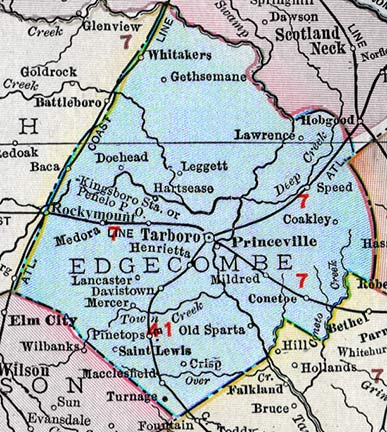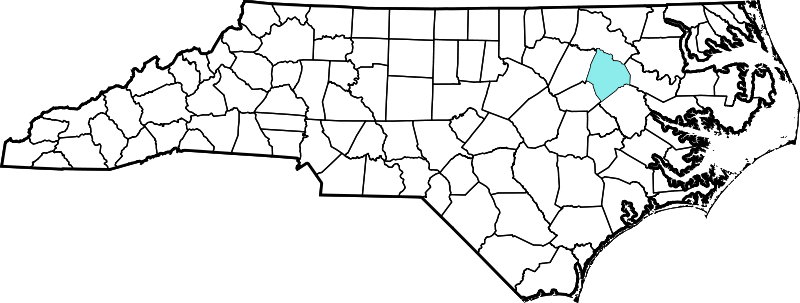WHO WAS
SHELDON STRINGER'S FATHER AND WHEN DID THE STRINGERS COME TO TAMPA?
Could Sheldon's
father have been related to one of the Edgecombe Co., NC
Stringers? Who was Mary Stringer, what was her maiden
name? Where was Alexander Stringer before he appeared in Tampa
on the 1880 census and was he really widowed?
Read about the mysterious Samuel Stringer; was he Sheldon's
brother and where did he go from
Tampa after 1850? He left few clues, except at the very end.
|
BIRTH PLACE OF
SHELDON'S AND ALEXANDER'S PARENTS
On the 1850
census of Tampa, Sheldon's mother, Mary, is listed as being
from NC. The first U.S.
Census to record the birth state of each person's parents
was the 1880 census. By that time, Sheldon
Stringer was living in Hernando County, Brooksville, was
married and had two children. There was also a much
older brother, Alexander, widowed, living in their home on
this census. This census shows that Sheldon's and Alexander's
parents were both born in North Carolina.
1880 Census, Hernando
Co., Brooksville, Fla.

Sheldon and Alexander both
born NC, with both parents born NC.
If Alexander really
is his brother, there would be 19 years in between them and
time enough for several more siblings.
|
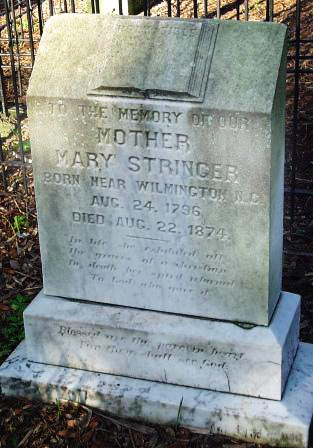
Photo by Donna McPherson at Find-A-Grave |
While
Sheldon was living in Tampa, he bought a plot in
Oaklawn Cemetery. His mother Mary is buried there and
according to her tombstone, she was born "near
Wilmington" NC on Aug. 24, 1796. She died on
Aug. 22, 1874.
Alexander Stringer is buried in Lake Lindsey Cemetery
in Brooksville, FL. |
|
His
tombstone shows he was born May 20, 1817 in Burgaw,
Alabama. This date is in agreement with his age
of 63 on the 1880 census. But Burgaw is not in
Alabama, it is in North Carolina, 25 miles north of
Wilmington in Pender County (which was formed from New
Hanover Co. in 1876.)
According to Alexander's birth date, Mary Stringer would
have been around 21 when he was born. He probably would
have been Mary and Mr. Stringer's first child.
|
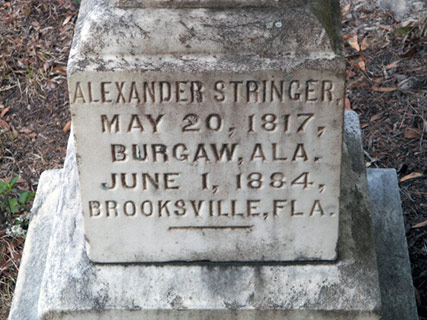
Photo from Find-A-Grave by Betty Lykes Stringer
Chapter 2407 UDC
|
|
Why did they think Burgaw was in
Alabama? Perhaps Alexander came to Florida from
Alabama and being born in Burgaw, they assumed it was
in Alabama? |
From "The History of Tampa’s Oaklawn Cemetery" By THEODORE
LESLEY
Sunland Tribune, A journal of the Tampa Historical
Society, Volume XVII November, 1991 USF Digital
Collections
At the
outset, burial lots were sold by the county at 2 ½
cents per square foot, each lot being approximately
400 feet square. In January, 1853, the cemetery
appeared for the first time on a Tampa map, when the
city limits were extended to include the area. On
December 7, 1855, the county commissioners appointed
William S. Spencer sexton and superintendent of the
"public grave yard." He was authorized to charge and
collect $5 for each corpse buried by him. E. A.
Clarke, county treasurer, was ordered to sell lots
in the public grave yard. Said funds were to be kept
separate from other funds and be known as the "grave
yard funds." To this was to be added the amount
received by the corporation of the town of Tampa
(then a defunct organization) for lots heretofore
sold, which funds were to be entirely used to fence
and to keep in repair the grave yard. To this amount
was added a bequest from J. W. Brookbank, M.D., who
died in May 1854, and being without immediate family
left $50 towards fencing the public burial ground.
Many
pioneer Tampa families purchased burial lots at this
time, notably James McKay, William T. Brown, Andrew
H. Henderson, John T. Givens, Sheldon Stringer,
M. C. Brown, John P Crichton, M.D., Franklin Branch,
M.D., the Kennedys, Perkins, DeLaunays, Grillons,
Ghiras and others in subsequent years.
|
|
POSSIBLE FATHER OF SHELDON STRINGER, SR. IN MADISON CO.,
FLA.
MADISON CO.,
FLORIDA HISTORY
The Hickasukis who first came to the area and the
Seminoles who followed them later were in undisturbed
possession of the area until after American rule in
Florida began in 1821, for Andrew Jackson’s invasion of 1818
did not touch the present Madison County unless in the
extreme western part.
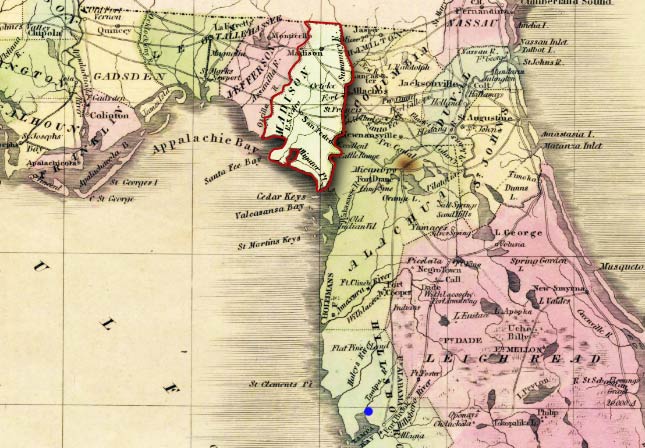 The
1842 map at left from the University of Florida digital map
collection shows Madison county's eastern boundary was the
Suwannee and Withlacoochee Rivers, it's western boundary the
Ocilla River, northern boundary the Georgia state line, and
southern boundary its coast along the Gulf of Mexico. The
1842 map at left from the University of Florida digital map
collection shows Madison county's eastern boundary was the
Suwannee and Withlacoochee Rivers, it's western boundary the
Ocilla River, northern boundary the Georgia state line, and
southern boundary its coast along the Gulf of Mexico.
The treaty made
at Camp Moultrie near St. Augustine, September 18, 1823,
provided for the removal of all Florida Indians to the
southern part of the Territory and John Hicks after whom
Hickstown in Madison County was named, was the chief whom
Governor Duval selected to superintend the removal of the
Indians in the present Leon, Jefferson, Wakulla, and Madison
Counties.
The removal of
the Indians probably occurred in 1826, but it is practically
certain that some were left. During the Florida War of
1835-1842, there were a number of skirmishes fought in
Madison County and several families were massacred.
(This will be alluded to later below in the life of Samuel
Stringer "Jr.") Forts
were built during this war near Sampala Lake and on the west
side of the Aucilla River near the present Lamont, and from
these companies of soldiers patrolled the surrounding
country at regular intervals in order to catch any Indians
who might be found. But the Florida War did not prevent
Madison County from making a rapid increase in population.
The increase between 1830 and 1840 was more than 400 percent
and at the latter date the population was 2,644.
Excerpt above
from
History of Madison Co., Fla by Ruby Woodbery, 1936 at
Genealogy Trails History Group, transcribed by Susan Geist.
SAMUEL
STRINGER FAMILY -
1840 Census, Madison County, FL
On the 1840 census of
Madison County, FL, there is a Samuel Stringer listed along with other
families who became
early Tampa settlers--Joseph Moore and
Benjamin Drew. A few years later, in 1843, carpenter
John T. Givens would settle in Madison Co. and come to Tampa
in 1848.
Samuel Stringer was age
40 to under 50 so he would have been born from 1791 to 1800.
He didn't own any slaves and was engaged in manufacture &
trade. He was probably a carpenter, as were his
neighbors. After the Sept. 1848 hurricane demolished
Tampa, the need for carpenters must have been great, and
this is probably the reason Joseph Moore and Ben Drew moved
to Tampa. But did Samuel come too?
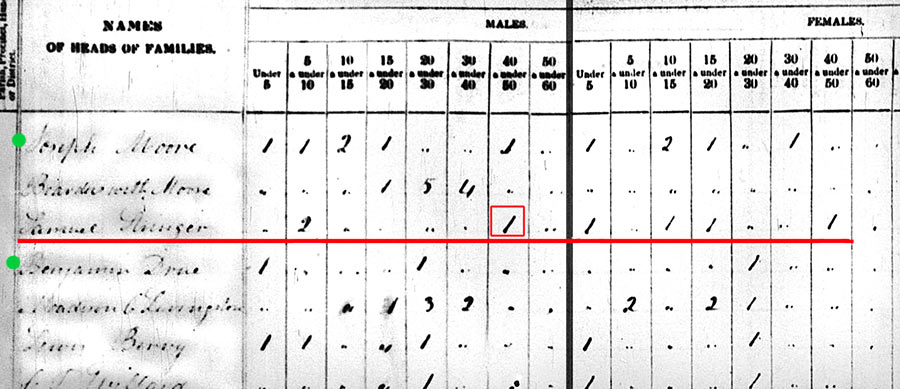
1850 Census, Hillsborough
Co., Tampa, p.8
John Givens family in Tampa--neighbors of the Stringer
family
See this page for more
about John T. Givens.
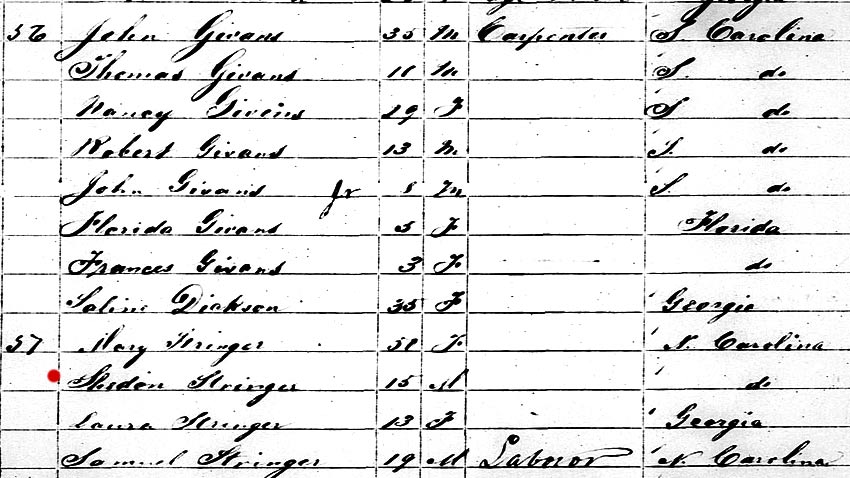
|
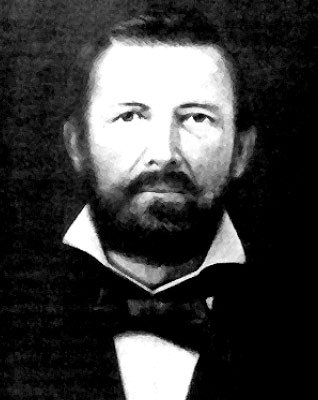 |
|
Joseph Moore photo from Hillsborough Lodge No.
25 E &A.M. |
Joseph Moore was a
Fayetteville, North Carolina
native born in 1799 who came to Florida by 1830 from Sampson
County, NC, to Magnolia, Leon County, FL. The Moores moved to Madison County by 1840 and from Madison
County, he and his family came to Tampa in 1842 settling on
the west side of the Hillsborough River at what now is Hyde
Park. He was a founding member of Hillsborough Lodge #25
in 1850 and was elected the first Worshipful Master of
Hillsborough Lodge, serving for three consecutive years.
His family emigrated to this country from Ireland.
He and his wife Elpenice Stanford
Moore had 11 children in all. In 1840, there
were 9 children left in their home, all under age 20.
Joseph and Elpenice Moore's daughter Maria Jane Moore
married Madison Post, who came to Tampa in 1849 and operated
the Kilgore Hotel. Post soon married Maria and opened
a general store and became Tampa's 5th mayor in 1858.
1850 Census, Hillsborough
Co., Tampa, p.9
Joseph Moore family

|
|
ACCOUNTING FOR THE CHILDREN OF THE 1840 CENSUS MADISON
COUNTY STRINGERS
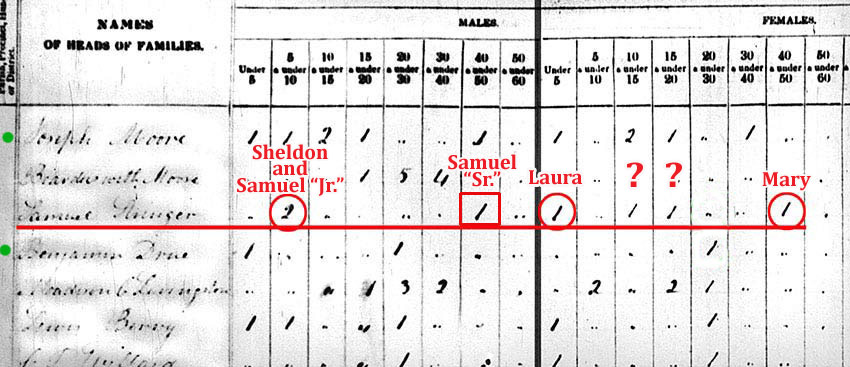
Of particular interest is
that the two males age 5 to under 10 could be the 1850
census' Sheldon (15)
and Samuel "Jr." (19) in
Tampa. In 1840, Sheldon would have been 5 and Samuel "Jr."
would have been 9 and thus fit in this age group. Also,
Sheldon's brother Alexander (of the 1880 Hernando Co.
census) would have been around 23 and
thus old enough to have moved out of his parents'
household--no male age 20 to under 30 is in the 1840
Stringer home.
The
female under 5 can be Laura, Sheldon's sister, who was born 1836-37 in GA and
would be around 3 or 4 in 1840. And finally, Sheldon's
mother Mary, who was born in 1796 (according to her
tombstone), to 1799 (according to her 1850 Census), would be around 41
to 44 and
can be the female age 40 to under 50. There are two
more females yet unaccounted for in the 1840 Stringer home: one age 10 to under 15
(b. 1830 to 1834) and one age 15 to under 20 (b. 1825 to
1829). These will be identified below. By 1850, they would have been old enough to have
married out. Nothing in this census would disqualify this
Samuel Stringer family from being the family of Dr. Sheldon
Stringer, Sr.
|
|
MARY ANN STRINGER
On Sept. 15, 1839,
Benjamin F. Drew married Mary Ann Stringer in Madison
County.
At right, the marriage record of Benjamin F. Drew and Mary Ann Stringer
in Madison Co., 1839
Benjamin F. Drew is
found in Tampa on the 1850 census (below) with
his wife Mary Ann and 3 children; he was a carpenter. His
son Octavius was 10 and the only male child in 1850.
On the Drew 1840 census of Madison Co., Octavius would
have been the lone male child under 5 (and probably
under 1 year old). Ben also had two daughters in 1850
in Tampa: ages 8 and 6, thus they would not be
on the 1840 census. Accordingly, no other
persons were listed in the Drew 1840 household.
Only Benjamin, Mary Ann, and their son Octavus. |
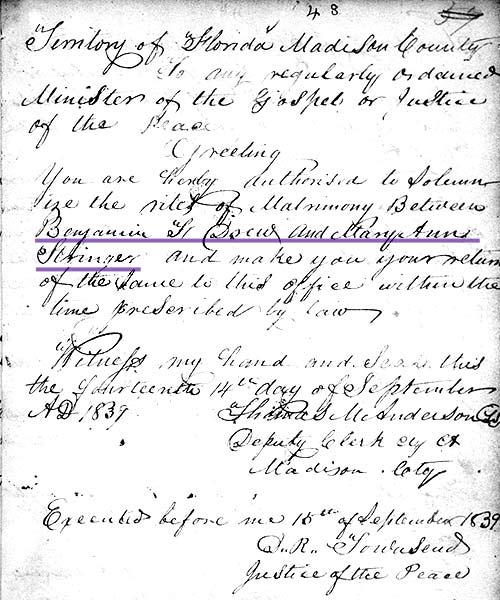
|
1850 Census, Hillsborough
County, Tampa (p.4)
Benjamin Franklin Drew

On the
Mar. 15, 1934 death record of a son of Benjamin and Mary
Ann Drew, Edgar Meredith Drew, Mary Ann is listed as Mary A.
Stringer, born in Wilmington, NC. (The same area Sheldon
Stringer Sr.'s mother was born according to her tombstone.)
Mary Ann Stringer Drew's
tombstone shows she was born Jan. 20, 1820. She
should have been 30 on the 1850 census, not 28 at listed
above.
Octavus C.
1840
Anna Caroline 1842 1842
William C.
1844 1845
Jane
1850
(There seems to
be no connection between Benjamin F. Drew and John H. Drew
who was a successful developer and contractor in Tampa in
the late 1800s. John Higley Drew was born in Clark
Co., AL in 1864 and came to Clearwater at age 8 with his
parents around 1874. He moved to Tampa in Jan. 1893 after
having developed much of Clearwater. In two short
years he was a major force in the development of Tampa.
Drew Air Field was named for him, as well as the Drew Park
subdivision, which he developed.)
1840 CENSUS MADISON COUNTY
The Drews lived by the Stringers on the 1840
census and shows the only female in Ben's home is age 20 to
under 30, which would have been his wife Mary Ann Stringer.
No doubt Mary Ann was a daughter of Samuel Stringer
their neighbor.
This would make 3 female Stringer children age 10 to under
30 in 1840, or born between 1810 to 1830, Mary Ann and the
two unknowns.
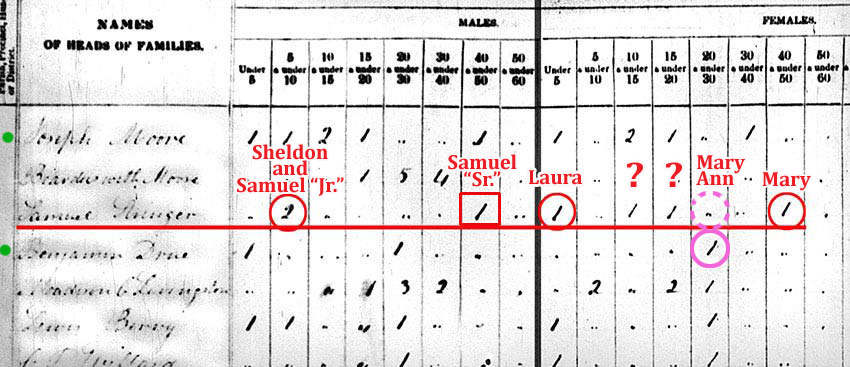
If Mary Ann Stringer Drew was
Sheldon's sister, she was probably named for her mother. If
these conclusions are correct, Samuel Stringer and his wife
should be found living somewhere around Wilmington in 1820
with at least one female under 1 year old (Mary Ann, who was
born in Wilmington, Jan. 20, 1820).
|
|
JANE
STRINGER Another
Stringer marriage took place in Madison County; this
one on June 20, 1841 when William Hammley (or Hemly, Hamley, etc.) married Jane Stringer. It appears that William was not yet in
Madison Co. by the time of the 1840 Census.
At right, the 1841 marriage record of
William Hammley and Jane Stringer in Madison County.
The Hammley family was still
in Madison County on the 1850 Census (below), where we see
William was also a carpenter. Here, Jane Stringer
Hemly was born in NC and was 30, so she would have been born
around 1819-1820 and would have been around 21 to 22 when
she married. Their youngest son was named Samuel. |
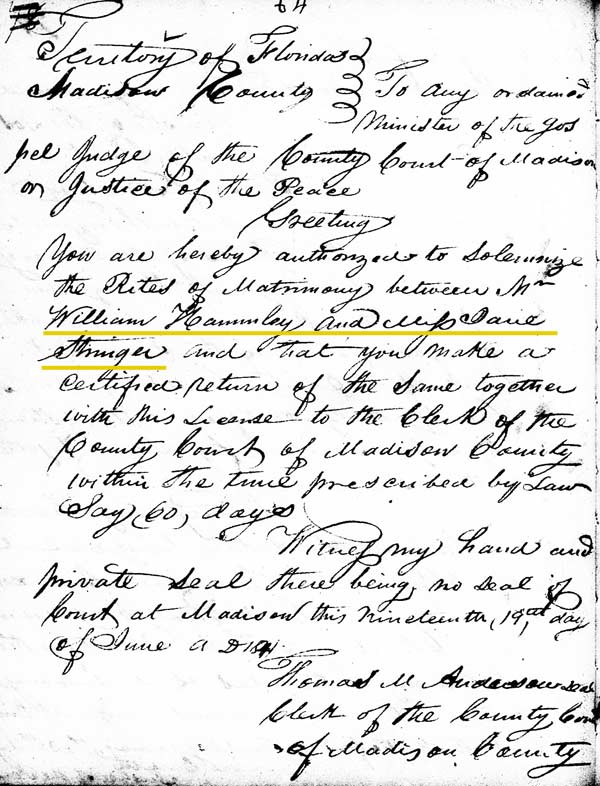 |
1850 CENSUS OF MADISON
COUNTY, FL
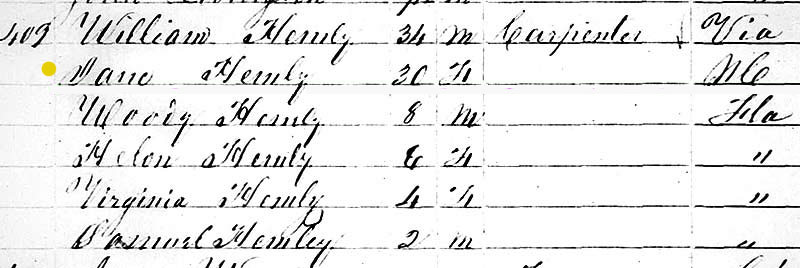
1860 CENSUS OF MADISON
COUNTY, FL
The Hamlys were still in
Madison County on the 1860 census, where we see William is a
master carpenter, born in Virginia. Jane A. Hamly is only 38 which
calculates this time to an 1821 to 1822 birth year.
She should be 40 here.
Now it shows she was born in Georgia instead of NC.
They've also named two daughters Virginia and Georgia.
The children's names and ages are extremely inconsistent
between the 1850 and 1860 censuses so it is impossible to
tell from just these two censuses which of the 1860 children
might be the same as an 1850 child but listed by middle name
instead of first name. For example, Helen who is 6 in
1850 should be 16 in 1860 but instead there is a 14 year old
Ellen in 1860. Samuel who is 2 should be 12 in 1860
but is absent, and instead there is a 12 year old Virginia in 1850 who was
4 in 1850.
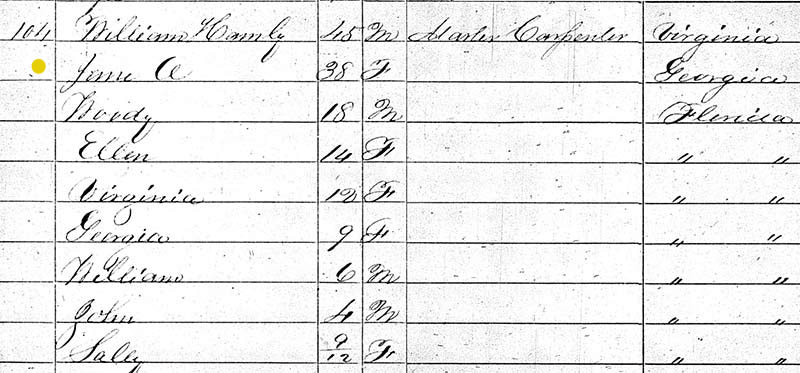 |
1840 CENSUS, MADISON COUNTY
Combining Jane's birth year
window for her two censuses, we get a birth year range of
1819 to 1822 and an age window in 1840 of 18 to 21.
Looking at the Samuel Stringer 1840 census of Madison Co.,
Jane fits in as the female age 15 to under 20 and the
overlap would be 18 to under 20, or b. 1821 to 1822. Her
birthday was probably some time in June.
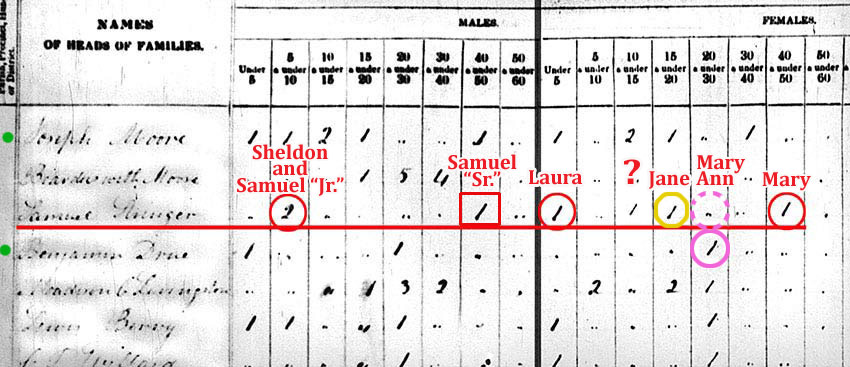
|
|
MARTHA STRINGER
On July 1, 1849,
James Cook married Martha Stringer in Hillsborough County.
(No image available.)
1850 CENSUS, TAMPA
James and Martha Cook are
found on the 1850 Census of Tampa, living by the Ferris
family and close to the James McKay family and not far from
Mary Stringer. There is also a 30 year old sailor from
NY named Michael Wall living in their home. James was a
stone cutter from Ireland, Martha was age 22, born in NC.
She would have been born 1827-28 and age 21 when she
married.

1860 Census, Hillsborough
Co., Tampa
James and Martha are also in
Tampa on the 1860 census. Martha's age is 28,
b.1832-33 NC, so she only aged 6 years since 1850.
They also have a 4 year old son named Thomas.

On the 1870 Census, the Cook
family had moved to Brooksville, Hernando Co. James, a
farmer, and Martha still have only one son; Thomas, age 12.
Martha is consistent with her birth place of N. Carolina.
1840 Census, Madison Co.
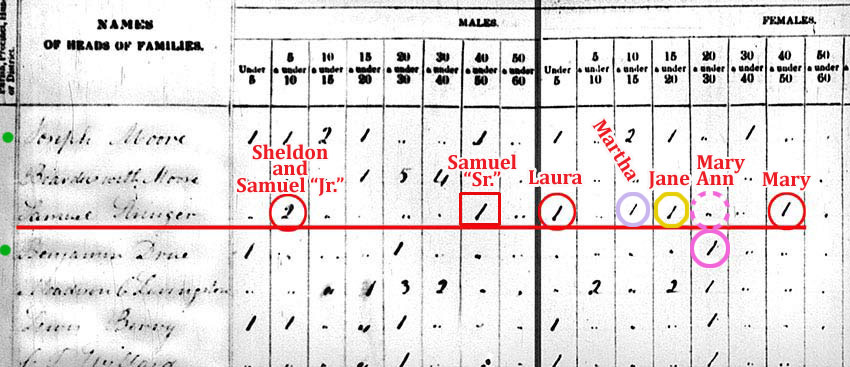
Using Martha's
combined age range of her 1850 and 1860 censuses, she would
have been born 1827 to 1833 and be age 7 to 13 in 1840, thus
fitting in the age 10 to under 15 group of the 1840
Stringer census in Madison Co. The overlap would
be age 10 to 13 in 1840 (b. 1827 to 1830.) The fact that she
married in Hillsborough County shows that the Stringer
family was likely in Tampa by July 1, 1849 |
|
ALEXANDER
STRINGER IN TEXAS - IS HE THE SAME ONE AS DR. STRINGER'S
BROTHER IN BROOKSVILLE?
The best
candidate to be Sheldon's brother Alexander before 1880 is one found in
San Antonio, TX in 1850. This Alexander Stringer, age
30, is found on a page where just about all are men serving
as "wagoner, qtr. master depot" for their occupation.
Also, the men's birth places vary from all over the country
and Europe. This goes on for quite a number of pages
and is apparently a military installation from the
Mexican-American war. Alexander is listed as born in
South Carolina. Just after him is a Charles Stringer,
age 19, born in North Carolina. They could be
brothers. Could this Alexander be Dr. Sheldon Stringer's
brother if we assume either his Florida census or his Texas
census is a mistake regarding his birth place?
1850 Census, Bexar Co.,
San Antonio, TX

The Texas Alexander Stringer was born c1819-20 in SC according
to this record. The one in Brooksville on the 1880
Census was born in North Carolina c1817. Listed after him is
a 19-year-old Charles Stringer, born in N. Carolina c. 1831.
They may be related.
The Alexander
Stringer in Texas would marry Elizabeth (Jane) Wilson in
1861. Below, her 1860 census:
1860 Census, Nueces Co.,
Corpus Christi, TX

Elizabeth Wilson, age 25, born
in Illinois c1835.
Also in the home is a 40-year-old
James Morgan and a 10 or 11 year old Louisa Wilson, probably
somehow related.
Nov. 10, 1861
Marriage of the Texas Alexander Stringer and
Elizabeth
Jane Wilson
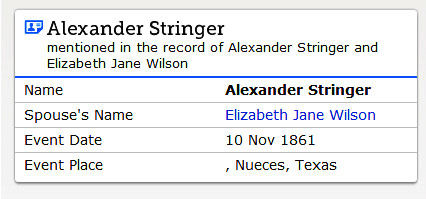
No census record found
for Alexander Stringer in 1860.
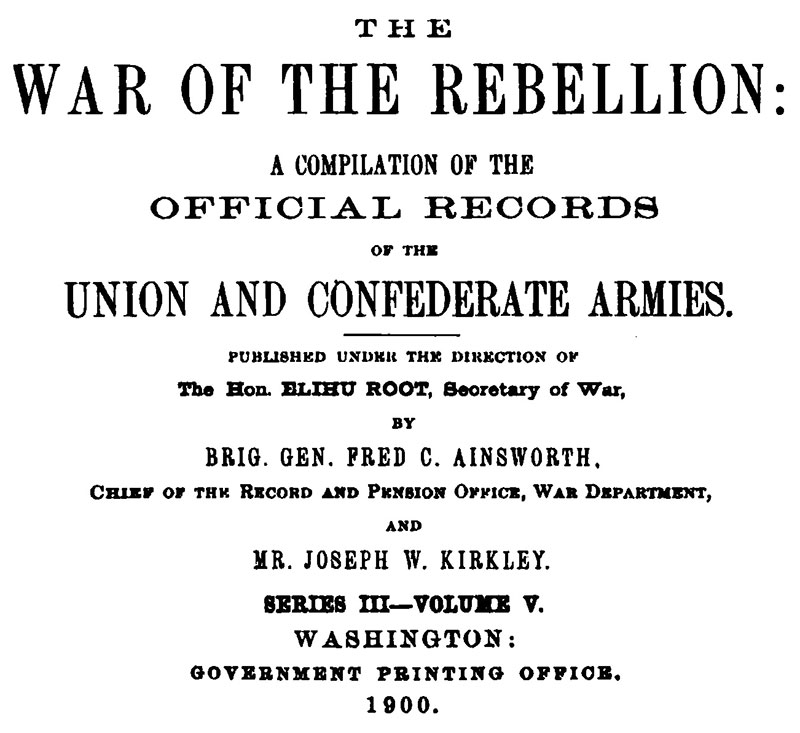
Images from Internet Archive
An Alexander Stringer is mentioned in Vol. 5 of Series 3 in
the above publication about the Civil War.
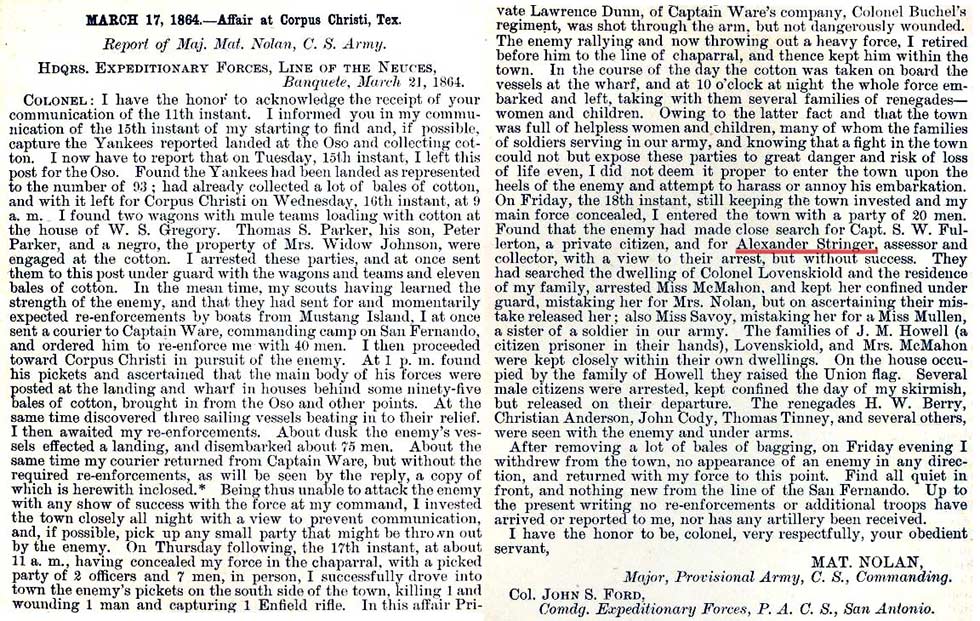
Alexander
Stringer is found on the 1870 Census of Corpus Christi, TX
with his wife Elizabeth. Of particular interest is that
in 1870 he is a carpenter, whereas in the account of "The
affair at Corpus Christi," Alexander is described as a
(tax?) assessor and collector. His age on the 1870 census is
55 (calculated birth year circa 1814-15) and again shows SC
as his birth place. Using Alexander's Florida age in
1880, he should have been 53 on the 1870 census. If he
is the same Alexander Stringer from the 1850 census in San
Antonio, he should have been 50 in 1870. It also shows
he was born in SC like the 1850 Texas Alexander Stringer.
Of particular importance is that they had a son named
Sheldon and this is a very good indicator that Alexander is
Dr. Stringer's brother.
1870 Census, Nueces Co,
Corpus Christi, TX - Enumerated June 17
NOTE:
This is not Dr. Sheldon Stringer of Tampa/Brooksville

Alexander Stringer age 55,
born c1814-15 SC
Elizabeth (Wilson) Stringer 37, born c1832-33,
Illinois.
Sheldon M. Stringer born c1864-65 in Texas.
Listed out of chrono order is Sarah M. Wilson, age 19, born
1851 Illinois. Her being listed out of chrono order
(if not a mistake) would indicate she is not a daughter of
the head of house. She could be a daughter of
Elizabeth Wilson from a prior marriage in Illinois.
Elizabeth Wilson would have been 18 when Sarah M. Wilson was
born.
1880 Census, St. Louis, MO,
814 N. 18th St., enumerated June 8 by E. L. Loucks
NOTE: This is not Dr. Sheldon Stringer of
Tampa/Brooksville

In the same year Alexander is
in Florida with his brother Sheldon, Elizabeth J. Stringer
was enumerated as head of house in St. Louis, MO, age 48, born c1832-33,
consistent with her 1870 census.
The census only asked for the birth state, but St. Louis, MO was
recorded. Clearly this is the wife of Alexander
Stringer from the 1870 Corpus Christi census.
Here she states she was widowed. Alexander in Florida
on his 1880 census with Sheldon says he was widowed. Situations such as this are
indicative of a divorce. (Unless we're looking at two
different Alexander Stringers.)
The same Sarah M. (or L.)
Wilson from the Stringers' 1870 Census in Corpus
Christi is in the home, but her age is inconsistent with her
1870 Census. Her age here points to an 1855 birth
year. Consistent with her 1870 Census, Sarah M. was
born in Illinois, with father and mother born Illinois.
This is consistent with Elizabeth having a prior marriage to
a Mr. Wilson in Illinois and Sarah being a daughter from
that marriage. From this info, Elizabeth would have
been 23 when Sarah was born. If John Wilson, Jr. is her son,
she might be the IL marriage record of an
Eliza Jane McGowen
who married John Wilson on Oct. 7, 1855 in Morgan Co., IL.
Sheldon M. Stringer's age is
consistent with his 1870 Census in Corpus Christi. At
15, he has an occupation of "Painter." He is suffering
with chills and fever. Born Texas, with father born
SC, which is consistent with Alexander's 1850 and 1870
censuses.
1880 Census, St. Louis, MO,
814 N. 18th St., enumerated June 9 by Joseph Hargate.
NOTE: This is not Dr. Sheldon Stringer of
Tampa/Brooksville

Apparently, two enumerators
covered the same area of St. Louis on consecutive days,
listing Elizabeth Stringer twice. This time Elizabeth is 2
years younger. Situations like this usually mean
someone other than the head of house provided the info.
Here is a 25-year old Louisa listed as her daughter.
Born in Illinois, she appears to be the same person as Sarah
Wilson in her previous day's census at the same
address. If Sarah was Sarah L. Wilson instead of Sarah
M. Wilson then Louise could be her middle name. She
can be traced back through every one of Elizabeth's censuses
under somewhat inconsistent ages and alternating between
Louisa and Sarah.
As previously covered,
Alexander Stringer shows up on the 1880 Census in Tampa,
also indicating he was widowed.

1900 Census, St. Louis, MO.
Sheldon M. Stringer, wife Annie and children Leo, Harry
and Eunice
NOTE:
This is not Dr. Sheldon Stringer of Tampa/Brooksville

Sheldon went on to marry
around 1887. On the 1900 census he was a musician, but
the birthplace of his father would change with almost every
census; . Here his father's birth place was listed as
Missouri. In 1910 his father from Florida. In
1920, Sheldon was a music teacher shows he was from Missouri
and both his parents are from "United States,"
In 1930, Sheldon was born in Texas, with father Texas and
mother Illinois--a possible indicator that he never really
knew where his father was from or Annie provided the
information and did not know. In 1930 Sheldon was a cutter
of art glass.
Conclusions from Alexander
Stringer
The most important clue that the Texas Alexander
Stringer is Dr. Stringer's brother is that the Texas
Alexander had a son named Sheldon.
The records indicating the Texas Alexander was born in SC
and the 1880 Brooksville Alexander showing NC tend to
indicate that one of these censuses inaccurate in that regard,
OR, we're looking at two different men.
Either way, the latest marriage year of Sheldon's parents
are limited by Alexander's birth year if he is Sheldon's
brother. Considering everything we know about
Alexander of all the records, Sheldon's parents could have
married any time from 1815 to 1817, and Sheldon's mother
Mary Stringer would have been as young as 18 at the time. |
|
SAMUEL STRINGER (the younger)
- A CANDIDATE FOR THE "MOST INTERESTING MAN IN THE WORLD"
It would appear that Samuel
Stringer who was in Tampa at age 19 on the 1850 census never
married; he turns up on the 1885 state census of Iowa in
Jackson, Adair County, with no occupation listed and in the
home of Jacob Shrader, a railroader, along with a handful of
other seemingly unrelated men. Samuel's age is
consistent with his 1850 census in Tampa.
1885 State Census of
Jackson, Adair Co., Iowa
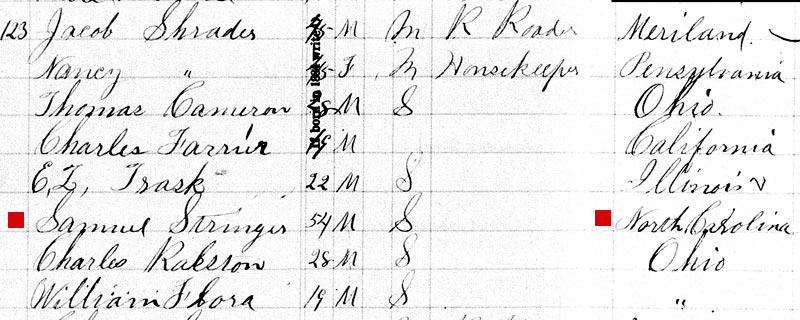
1900 census in Buffalo
Town, Johnson Co., Wyoming
Fifteen years later, Samuel
was a mail carrier and had a servant.

No other records
have been found for Samuel thus far, but there are numerous
stories written about him. He was quite a well-known
man in the Old West.
Samuel Stringer at Find-A-Grave:
THE SHERIDAN
ENTERPRISE - September 23, 1905 Obit provided by Karylyn
Petrie
Death brought to an end a notable life when Sam Stringer
passed away at the state hospital Sunday afternoon at the
age of 74 years. Mr. Stringer, before the war was a
teamster in the employ of the government at a Texas fort.
When the war broke out he followed the commanding officers
and troops who joined the Confederacy. Before the war was
over, he came north and again became a teamster at Fort
Leavenworth, on the union side. He served in all the posts
along the line from Leavenworth, including old Fort
Kearney in Nebraska, Fort Laramie and Fort Bridger. In
1866 he was assigned to Gen. Carrington's command in the
expedition that built Forts Reno, Phil Kearney, and C. F.
Smith on the old Bozeman road. During the later part of
that year he was located at Fort Phil Kearney. When the
Indian fight that is known as the Fetterman massacre
occurred on December 21, he was ordered to the battlefield
with his teams to bring in the dead a few hours after the
deed was done. The massacre occurred along about noon and
about 8 o'clock in the evening he returned, bringing in
the bodies of Capt. Fetterman and Capt. Brown in his own
wagon. When he obeyed the order of his officers he said he
never expected to get back alive as he thought the Indians
would get the balance of the command.
After remaining in the service for several years, he
resigned and ever since has been interested in mail and
stage contracts in this section. He never tires of
telling of the advantages of Northern Wyoming over every
other place. He took part in all the Indian wars in
Wyoming. He joined the Masons in the early days while
located at Fort D. A. Russell at Cheyenne. The funeral was
held under the auspices of the Masons in Sheridan and
interment was made in Mount Hope Cemetery.
Dec. 21, 1866 - The Fetterman Massacre at Ft. Phil Kearney
There was also an obit in the
Sheridan Post, Sept. 19, 1905 page 1. Most of the info is
the same with a few additional facts.
For many years he has
been running state line, and at the time of his death,
which resulted from chronic dysentery, he had a mail
contract running south from Buffalo. The deceased came to
the hospital at Sheridan nearly a month ago. Little or
nothing is known of his family connections. Just before he
died, he tried to tell the nurses something but he waited
too long, until his whispers could not be heard or
understood. It is said that he had a niece, somewhere in
the east. Those who knew the deceased say he led a clean,
honorable life.
Find A Grave,
database and images (https://www.findagrave.com :
accessed 02
October 2018),
memorial page for Samuel Stringer (unknown–17 Sep 1905),
Find A Grave Memorial no. 119599708,
citing Sheridan Municipal Cemetery, Sheridan, Sheridan
County, Wyoming, USA ; Maintained by Marsha Hanson Dillon
(contributor 46953066).
Below from "Annals of Wyoming" by the Wyoming State
Historical Society
at Internet Archive
|
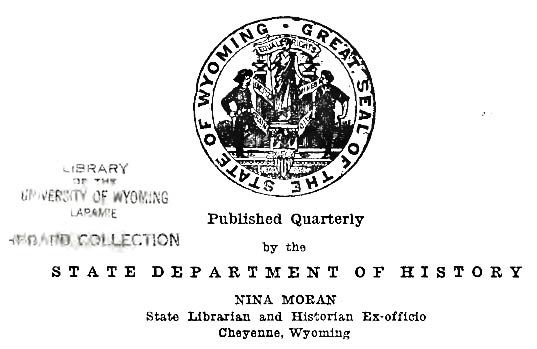
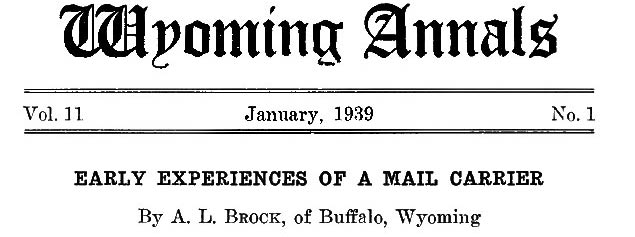
Vol. 11 January, 1939 No. 1
EARLY EXPERIENCES OF A MAIL CARRIER
By A. L. Brock, of Buffalo, Wyoming
September, 1935.
It might be permissible to mention a few things in regard
to Sam Stringer's past history, a part of which he told me
over forty years ago.
When a young man he was a teamster in the Confederate
Army and at the Wilson Creek battle near Springfield, Missouri, he lost his entire outfit.
He then came as a teamster with
General Carrington in 1866 to where Fort Phillip Kearney was
established in what is now Johnson County, Wyoming, in 1866.
He told me he would have been with the wood train when it
was attacked by the Indians had it not been that his wagon
was at the Fort at the time for repairs. He was one of the
men from the Fort who assisted in bringing in the bodies of
the dead soldiers killed by the Indians at what is now known
as "The Fetterman Massacre" at "Massacre Hill," where Fetterman with seventy-eight soldiers
and two civilians were killed December 21st, 1866.
Mr. Stringer drew a small pension for fighting Seminole
Indians in Florida as a volunteer.
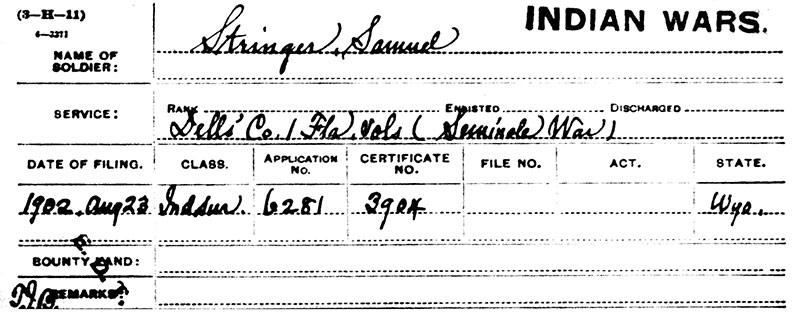
[TampaPix note: There was
a Capt. James G. Dell of the Florida volunteers as
seen below.]

He was also with General George A. Custer, as a teamster, in 1868 when Custer left Camp Supply, December 7th,
1868, with about fifteen hundred soldiers to fight Indians.
Custer located a large camp of Cheyennes with Medicine
Arrow as principal Chief, on Sweetwater, a tributary of Red
River, December 17th. Custer was trying to locate two white
women who had been captured by the Cheyennes while raiding Salina, Soloman, and Republican Valleys in Kansas during
the summer and fall of 1868. One of the women, 19 years old,
was Mrs. James S. Morgan (formerly Miss Brewster) who was
a bride of less than a month. The other was a Miss Sarah
White, 18 years old. When Custer ascertained that these two
women were in this camp and knowing what their fate might
be if he attacked the camp, after meeting some of the Indians
with a flag of truce, he used strategy to get possession of the women. After
four or five days of dickering and holding some of the Chiefs as hostage for
their safe delivery, he succeeded in having the women turned over to him. Daniel
A. Brewster, a brother of Mrs. Morgan, was with Custer and the first one to meet
his sister. Mr. Stringer was with Custer at this time and also the late W. G.
Angus of Buffalo, Wyoming. Each of these men related to me some of the
happenings of this particular event. I was informed that the bands played "Home,
Sweet Home" while these two women were approaching the soldiers, and Mr. Angus
said he thought it was the sweetest music he had ever listened to. Mr. Stringer
gave me rather a vivid account of this entire affair. On their departure for
their former home the soldiers took up a collection and presented to the two women, over seven hundred dollars.
I might say, also in conclusion, that Mr. Stringer at one
time had several mule teams and did construction work in
railroad building, and at one time was robbed of several thousand dollars.
Mr. Stringer worked for the Government as a civilian
teamster for several years. He also carried the U. S. Mail for
a number of years, over various routes, and at the time of his
death he had the mail contract from Buffalo, Wyoming, to
Sussex, Wyoming.
Vol. 11 January, 1939 No. 1
During the latter part of March 1892 Sam Stringer was
carrying the U. S. Mail from Buffalo via Mayoworth across
the Big Horn Mountains to Ten Sleep, Wyoming. The snow
at that time was rather deep on the mountains between Mayoworth and Ten Sleep. While Mr. Stringer used only one
team of mules from Buffalo to Mayoworth, he used four to
carry the mail over the mountains when the snow was deep.
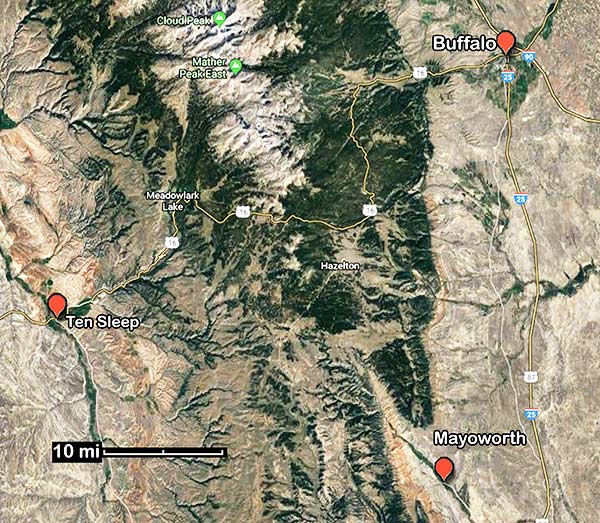
After leaving Mayoworth and reaching his cabin on the
head of Pass Creek on the mountains, he left his mules tied
to a light wagon and continued on snow shoes to Ten Sleep
pulling a toboggan loaded with the mail. After an absence of
seven days from Mayoworth, W. W. Morgareidge, J. R. Morgareidge, W. S. Jones and
myself started out to ascertain why he had not returned. After going as far as
was possible on the mountains with horses, the writer looked after the horses
while the other three men went on snow shoes to the cabin on Pass Creek where
they found the mules tied to the wagon still wearing the harness. The mules had
succeeded in reaching the hay and grain on the wagon and had gnawed quite a
bit of the wagon box including the hickory wagon bows.
The three men spent the night at the cabin, while I stayed
over night with the horses, three miles back on the trail.
During the night the wind blew my camp fire away and I put
a saddle and blanket on one of the horses, which was accustomed to being in the stable, to keep him from getting so cold.
I might add that I passed a very disagreeable night as caretaker of the horses.
The three men, after their night at the cabin, turned the
mules loose and brought them to where they could get feed
and then came to where I was with the saddle horses. We
concluded that Mr. Stringer had perished and was under some
snow drift. We then returned home, this being the ninth day
since Mr. Stringer had left Mayoworth.
We learned later that Mr. Stringer, on the return trip
from Ten Sleep broke one of his snow shoes, became very sick
and was about three miles from the cabin on the night that the
three men stayed there. He crawled on his hands and knees
most of the way from there to his cabin as he was sick and had
only one snow shoe. When he reached the cabin he didn't
have any matches and in order to start a fire he picked his
handkerchief to pieces and made a pile of lint and then covered this with fine shavings and shot into it with his six
shooter.
After staying there several days while recovering from
his illness and eating what provisions he had, including tallow
candles, he started for Mayoworth with the mail sack. When
he reached the point where he found the mules he took some
cord from his snow shoes, tied the mail sack on one of the
mules and tried to bring them with him. but the mule got away
and he could not catch him again.
Mr. Stringer was so very weak that he started on for
Mayoworth leaving the mail sack on the mule. Soon after
leaving the mules a severe storm struck him. He went into the
timber and while sleeping by the fire his clothing caught and
he burned a large hole in the back of his coat. He ate pitch
from the trees during the three days storm. At one time a
gray wolf was following him and kept getting closer and
closer. Stringer wanted the wolf for food. When it approached as near as he thought safe he drew down on it with
his trusty six shooter, fired, but missed the wolf, and it ran
away. Stringer stated that he felt so badly that he wept. He
then continued his journey and finally reached what was at
that time the Cochie Ranch, about four miles west of Mayoworth, in a very weak condition and his feet badly frozen. Cochie saturated his feet with coal oil which probably saved
them from having to be amputated later.
Mr. Stringer told me that while he was sick and delirious
he could hear people talking in Buffalo and recognize their
voices.
George B. McClellan and Tom O'Day came across the
mountains on snow shoes and seeing the mule with the mail
sack on him, took the sack and brought it in with them. The
mules were later brought in by Jerry Morgan. The rivets on
the leather mail pouch had made sores on the mule, causing the
hair to be white when healed.
After the harrowing experiences of Mr. Stringer, it was
found that the mail sack contained but one lonely letter.
It is commendable as well as an example of the loyalty
and trustworthiness in trying to keep the mail sack with him
when he thought he was facing possible death from sickness
and hunger and exposure.
After recovering from his serious adventure he again resumed his duties as mail carrier. He had carried U. S. Mail
for many years and over various routes, and at the time of his
death had the mail contract from Buffalo to Sussex, Wyoming.
He was a good citizen, loyal to his Government, true in his
friendships, and during his last illness, he being a Mason, was
cared for by the Masonic Fraternity.
A. L. Brock,
Buffalo, Wyoming,
September, 1935.
|
| |
|
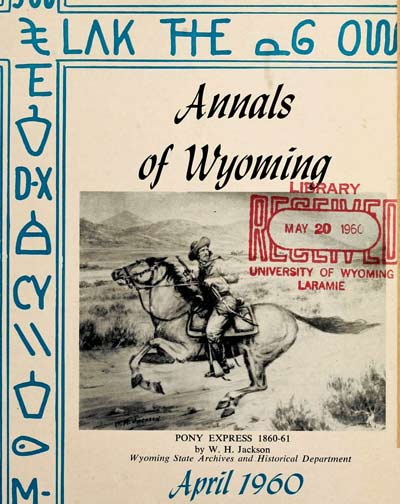 
The following narrative on Sam
Stringer is a result of these sources,
with text in their respective colors:
"Sons of the West," Chap. 4,
pp 68-78 at Internet Archive
COMBINED WITH
ANNALS OF WYOMING, THE HOLE IN THE WALL
by Thelma Gatchell Condit, April 1960, p.87-95. |
|
The early day post offices bring to mind the
stouthearted stage drivers who played no menial part
in the drama of the Old West. Their long, lonely years
of service and strenuous efforts to keep their
communication lines going between these isolated spots
for the most part remain untold. Surely they deserve
appreciation in recounting early day history--they and
the faithful teams they drove over the many lonely,
weary miles, day in and day in and day out, in good
weather and bad weather alike. Some of these drivers
were like old soldiers in loyalty and
conscientiousness in the line of duty.
They are a part of our fabulous heritage.
One of these drivers was Samuel Stringer, and
according to Mr. T. J. Gatchell, of
Buffalo, Wyoming, was among the pioneer stage drivers
and mail carriers
in the part of Wyoming that is now embraced in the
counties of Johnson and Sheridan and part of the Big
Horn Basin country.
It would be an impossibility to write a complete
history
of Old Sam, who participated so actively in the taming
of the West. He was a strange individual; even though
his life was crowded with all kinds of adventure he
thought his experiences ordinary ones and not worth
discussing.
It was not an easy task to induce him to talk of the exciting years
he had spent in the old west.
Samuel Stringer was born September 30, 1830, near
South Washington, North Carolina and died at Sheridan,
Wyoming, September 17, 1905. Of his early history the
writer knows but little, however, he went to the state
of Florida at an early age as, when but eleven years
old he was in the Seminole Indian war in that state.
The writer has always assumed that Mr. Stringer
resided in Florida until the Civil War, but am not
positive that such is the fact.
At the
outbreak of the Civil War he was employed as a
teamster with the Confederate Army; was captured by
the Union forces at the battle of Wilson Creek--which
event made a decided change in his affairs and was the
beginning of a long term of service with the regular
army.
[The
Battle of Wilson's Creek,
also known as the Battle of Oak Hills, was the first
major battle of the Trans-Mississippi Theater of the
American Civil War. Fought on August 10, 1861, about
10 miles southwest of Springfield, Missouri, between
Federal forces and the Missouri State Guard, it is
sometimes called the "Bull Run of the West."]
"Sam's story," Gatchell continues, "was brief, as were
all the narratives he told concerning himself. Of his
capture by Union troops he
said: 'I was captured at the battle of Wilson Creek by
the Yanks and they also got the team I was driving--a
six-mule string--and they were good mules and I hated
to lose them. I went before the Commanding Officer and
put up a good talk; told him they were my mules; that
I was only working for the Rebs and that team of mules
was all I had in the world. I also told him that I had
to have a job and if he wanted me to work for his army
I would do so. My story stuck and I went to work for
the Union Army.
During the Civil War he was employed as a teamster in
the Union Army, so in 1866 when the 18th Infantry was
ordered to go into what later became Wyoming Territory
to establish a line of forts along the Bozeman Trail,
Sam was with the expedition and met with some rough
aspects of frontier life while Ft. Phil Kearny was
constructed. He never was a soldier, just a teamster.
and his wagon was the first one to be loaded with the
Fetterman Massacre dead. Years later while driving
mail between Sheridan and Buffalo, he said, "I'm not
superstitious in any way, but when I drive past this
battlefield day after day all I have td do is close my
eyes and I can see those dead bodies laying there as
plain as I could the day we found them nearly 31 years
ago.
In an article on Sam Stringer that
appeared in the Wyoming Stockman-Farmer a number of
years ago, Mr. Gatchell wrote the following story,
used here with his permission:
'Old Sam Stringer,' as we all knew him, was a familiar
figure in Buffalo some thirty years ago. He was a
strict adherent to the rules of the postal department
and performed his duties as a 'star route' carrier to
the letter and the weather was never too cold, or the
roads too bad for him to get through with the mail, or
at least to make a supreme effort to do so.
Mr. Gatchell tells of Stringer's being at Fort
Leavenworth, Kansas, at the close of the war as
teamster with the Eighteenth Infantry. When, in the
spring of 1866, the Carrington Expedition came into
Wyoming. Sam Stringer was with them.
Mr. Gatchell records:
"When they arrived at Fort Laramie,
Wyoming, the Government
Peace Commission was in session and, notwithstanding
the promise made by this commission that the Indian
hunting ground was not to be disturbed, the Carrington
Expedition went on to carry out the order to establish
Military posts in the country practically ceded to the
tribes. This mistaken policy of the government cost
hundreds of lives, untold suffering and many thousands
of dollars as it resulted in two years of bloody
warfare and, in the end-because of lack of men in the
field and insufficient arms and ammunition-the country
went back to the savages and remained under their
domination until the so-called Sioux War of 1876.''
General Carrington (as he was later commissioned)
wrote in his scrapbook, Wyoming Opened, that,
seeing the condition caused by the result of the Peace
Commission, he wrote in to Washington, explaining what
the treaty was promising the Indians and asked that
the Expedition be halted. He remained at Fort Laramie
long enough to receive a curt answer, instructing him
to move on to the Piney District. He stopped at old
Fort Connor on the Powder, relieved the U. S.
Volunteers stationed there, and changed the name to
Fort Reno, under the order from War Department. From
here they continued on to the forks of the Pineys,
arriving on the 13th of July, 1866.
"From this point," Mr. Gatchell records, "Colonel
Carrington, with a suitable escort made a
reconnaissance of the country to the north, but
finding no suitable spot for a post within reasonable
distance decided to build the second fort at the Piney
location. This post was to be headquarters for what
was known as the mountain district and the actual work
of construction was started on July 15. The post was
commissioned Fort Philip Kearny as per order of the
war department and was located about 16 miles north of
the present city of Buffalo.
"Mr. Stringer said that with the selection of the site
things began to assume a decidedly busy aspect. A
logging camp was established in Big Piney Canyon about
6 miles west of the post; a sawmill put in operation;
the wagon train put to hauling logs and every
available man of the command busy with the work of
construction. Mr. Stringer as a teamster, was with
those engaged in hauling logs and said that the work
was anything but enjoyable.
"The tribes under the wily Red Cloud had declared war
and the savages did not overlook an opportunity to
harass the working parties. Several men were killed at
the logging camp and other details and quite a number
wounded. Stock was run off; every train attacked and
the garrison was kept constantly in fear of a general
assault. . . . Then to add to their troubles, the fact
of the establishment of the line of forts along the
trail (opened by John M. Bozeman for the convenience
of emigrants) had at least given tacit assurance that
Military protection would be given the numerous
emigrant trains that were traveling over the new road
to the recently discovered gold fields in Montana.
While it is true that many of these trains were amply
equipped to take care of themselves, on the other hand
the vast majority were not in any way capable of
passing through a hostile country and the Military
Authorities were hard pressed to offer any degree of
assistance to these outfits.
The Fetterman Massacre
"The climax to the troubles of the over-burdened
garrison, however, came on December 21, 1866, when
what is known now as the Fetterman Massacre took
place. The wood train had left that morning on what
was to be the last trip of the winter and when about
two miles west of the post, was attacked by savages."
Here is where the two men, Murphy and Stringer, both
at the post during those stirring days, disagree.
of that
memorable disaster Stringer said: "A relief party
under Brevet Lieutenant Colonel Fetterman was
dispatched to the assistance of the train, but with
specific orders to relieve the train and not under any
circumstances pursue the Indians beyond a stated
point."
Mr. Gatchell tells of meeting Mr. Stringer in 1896, at
which time he had the contract for carrying the mail
on the Buffalo-Sheridan route. Gatchell's account
continues: "From a number of sources I learned that he
had been at Fort Philip Kearny from the establishment
of the post in '66, until it was abandoned in August,
1868, and was desirous of getting his story of these
historical times. I made several attempts to get him
to talk about his experiences at the fort, but was not
successful until in the summer of 1897, he surprised
me one day by inviting me to visit the site of the
Fetterman Massacre with him. He told me the story on
the ground where, nearly thirty-one years before the
grim tragedy had been enacted. He said: 'As you
probably know, I was not a soldier, but employed as a
teamster by the quartermaster. The morning that this
terrible massacre took place I did not as usual
accompany the wood train, as my wagon needed fixing
and I remained at the post to have it attended to.
When Colonel Fetterman and his men failed to return to
the post another detail under Captain TenEyck was
ordered to go to their assistance and I asked to be
allowed to accompany them with my team, to haul the
extra ammunition.
My reason for wanting to go was because of the fact
Captain Brown, under whom I had worked, was with
Fetterman and I was much concerned for his safety.
Captain Brown had been a wonderful friend to me, was
in fact the whitest man I had ever worked for and,
while I was not a fighting man, I would have gone any
length to assist him."
'Our party crossed Piney Creek about at the Bozeman
Trail crossing but did not follow the trail, going
instead to the high point north of the post from which
place Captain TenEyck believed he could locate the
Fetterman command. When we reached the point however,
we could see nothing of Fetterman, but discovered that
the country to the north was literally alive with
Indians and an orderly was sent back to the fort with
that information, also asking that a cannon be sent
out to us. The cannon was not sent but an additional
forty men under Captain Arnold was dispatched to
augment our forces. "
'We then started down the ridge to the north the
Indians abandoning the country as we approached and
when we reached the point where the Bozeman Trail came
down the Piney Divide, we found what we were looking
for. There in a natural circle of rocks, apparently
thrown there by the savages, we found the bodies of
forty-nine of Fetterman's men. They had been stripped
of all clothing and were mutilated in a most horrible
manner. It was a sickening sight and will remain in my
memory forever."
'I can never put in words the sorrow that I felt when
I found the body of Captain Brown and realized that my
friend was lost to me forever. As night was nearly on
us and we realized that it would be impossible to
locate the balance of the Fetterman command that day,
the forty-nine bodies were loaded on my wagon and we
made our way back to the fort. The following day a
detail under the personal command of Colonel
Carrington returned to the field and the bodies of the
other thirty-two were recovered. I also accompanied
this detail. It was plainly evident that Fetterman had
allowed the decoy party to lead him down the ridge
nearly two miles of the place where we found the first
bodies.
"'The detail of the Second Cavalry, commanded by
Lieutenant Grummond had evidently been covering the
retreat of the main body and they were found at a
point on the ridge about half way from the extreme
north end and the place where the men with Fetterman
and Brown had fallen. Another fact that is seldom
mentioned is that just below the point where
Grummond's men made their last stand we found the
bodies of two men who had evidently been killed by the
Indians some days before the Fetterman fight. They
were unknown to any of us and were evidently miners or
trappers. We brought the bodies back to the post with
the other dead and buried them in the fort cemetery.
"Mr. Stringer was not in the
Wagon Box fight of 1867, but was familiar with the
location of this famous encounter and visited the
place with the writer in the summer of 1900. He passed
the site many times both before and after the fight
and could not be mistaken as to the exact location."
There has been much controversy as to the exact
location of this encounter, some placing it in Johnson
County, and others, just over the line in Sheridan
County. When the Civilian Conservation Corps erected a
native stone monument to this event a few years ago,
they placed it in Sheridan County.
Sam was with the wagon train in 1876 with which the
notorious Calamity Jane was employed.
The Gatchell account continues: "In the fall of 1876,
when General Crook made the last campaign of the
Sioux, Mr. Stringer was with the supply train
accompanying the troops. They established Cantonment
Reno on the Powder River at a point some three and a
half miles up the river from old Fort Reno. This
cantonment was afterwards named McKinney in honor of
Lieutenant McKinney, who was killed in the McKenzie
fight on the Red Fork of the Powder, on November 25,
1866.
"In the winter of 1878-79, when Fort McKinney was
established on Clear Creek, two miles west of the
present Buffalo, Stringer was with the wagon train at
the post
employed there a teamster.
The wagon-train headquarters was transferred from Fort
McKinney in 1886 to Camp Carlin, near Cheyenne, and
Mr. Stringer worked there
and stayed with it
until
it was abandoned
some time around 1898, when he returned to Johnson
County.
From then on he made his home in and around Buffalo,
serving as mail carrier on practically all the early
day routes
until the time of his death.
Sam performed his duties as a mail carrier to the
letter; the weather was never too cold or the roads
too bad for him to get through with the mail, or, at
least. make a supreme effort to do so."
"As was before stated, Sam Stringer was a strange
individual. He was always pleasant and agreeable, but
not inclined to casual conversation.
In
addition, he had many peculiar habits, especially so
in regard to diet. . . . He was overly fond of grease,
not any particular kind of grease, just so it was
grease.
Absolutely nothing in the way of food that wasn't
greasy was worth eating, according to Sam. He said
he'd never eat an alligator because it had no grease.
His travel rations always consisted of a can of grease
and a loaf of bread. He would heat his grease and sop
his bread in it, much like the dunkers of today
He would pop it into his mouth and smack satisfyingly
as if it were the best food in the world,
and any of the hot grease that was left, he would
drink.
He
often told me that he would rather have a cup of hot
grease any time than a cup of coffee.
He said the grease kept him warm on long, cold drives,
and it probably did.
"Mr. Stringer was very partial to a mule and most of
his staging was done behind a pair of those long-eared
hardy
animals. No one ever saw him use a whip on his mules,
but he had a special contrivance of his own which he
used when in his opinion they were loafing on the job.
This affair was nothing more than a few links of log
chain fastened on the end of a whip stock which he
would get out and rattle over them. The invention
always seemed to get the desired results, but my
curiosity got the best of me one time and I asked Sam
how it was, as he never struck the mules, that they
always seemed to come alive when he rattled the chain.
His reply was: 'Those mules know me and also know if
they don't get a move on when I jingle those links
over them that I will whale the everlasting daylights
out of 'em.
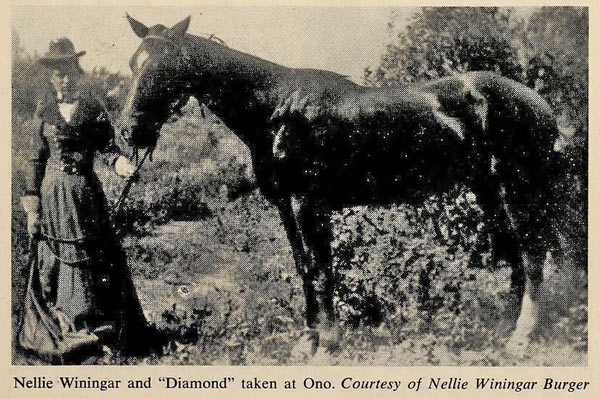
Nellie Winingar Burger says she well remembers Sam's
stage (on the Ono route) which, at the time, was a
light wagon or buckboard covered with canvas. making
an almost square top back of the driver's seat. The
canvas sides rolled up and down as needed for warmth
or ventilation. He had a couple of "bull's eye
lanterns" fastened at the sides of the front seat to
light the road at night should circumstances
necessitate his traveling after dark. He usually drove
four mules on the Ono route, stopping there for dinner
and on to Mayoworth for the night and on over the
mountains to Tensleep the following day. Sam had a
little cabin up the slope to use in emergency in case
it stormed or something.
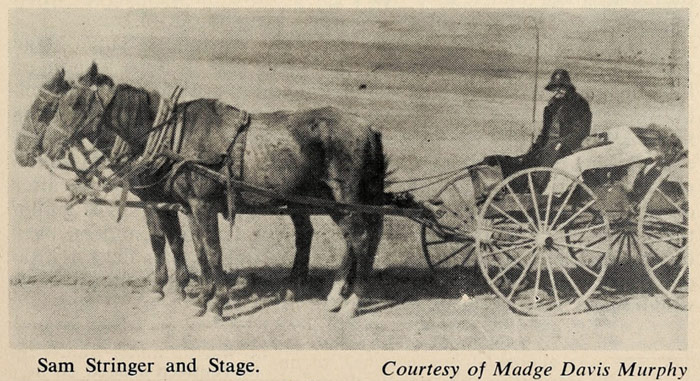
Mrs. Madge Davis Murphy of Kingsburg, California. who
sent the picture of Sam, writes, "How well I remember
old Uncle Sam Stringer and this old team and by-those
black dots in the background are cattle grazing. This
picture was taken somewhere between Buffalo and our
old ranch ("Spectacle" outfit owned by H. W. Davis)
where the Sussex post office used to be. Sam then
drove a little team of Indian ponies and wore high
boots with heavy woolen stockings sticking out above.
How well I remember him! We kids often rode on the
stage with Uncle Sam and he was so kind to us."
In fact, Sam had gained such a reputation as an
experienced, veteran mail carrier that the Post Office
Department requested a sketch of his life.
In the April 21, 1892, issue of the Buffalo Bulletin
is told the story of Sam's crossing the Big Horns in
late winter, which trip with its terrible suffering
and miraculous escape from death, unsurpassed even in
wartime chronicles, made him a hero unmatched in
courage and devotion to duty-which event of bravery
caused his story to be placed in Post Office
Department files.
All old-timers so well remember that the Big Horns in
the winter of '92 were deep with snow. Trails led
across the mountains in several places and were in
reality only early game and Indian trails which had
been slightly improved by the settlers. There was no
set rule for following any particular road over the
mountains. The mail carriers knew the country and how
to get across and used their own judgment about the
route, which decision was always determined by the
weather and passengers at hand. But the old NH trail
road was one most often used, starting up the slope
near the L. R. A. Condit ranch and following up a
small tributary of the Middle Fork of Powder River,
then across the divide and down by Little Canyon Creek
and Spring Creek to the old W. A. Richards' ranch and
then on to No Wood. From that place it was easy to
reach Tensleep and go on to Hyattsville and the upper
Basin country.
Then there was the other road farther south going
across from the old Barnum post office, which
connected up the same on top of the divide.
On the 29th of March, 1892, Sam Stringer made a never
to be forgotten effort to carry the mail from
Mayoworth to Ten Sleep via the old N H trail. This was
the first attempt that winter to get the mail across
the mountain. because of the deepness of the snow and
the severity of the weather. Sam started out with a
light spring wagon and four mules. but he did not even
make his little cabin the first night. So he unhitched
the mules on a little bare knoll abut a quarter of a
mile from the cabin, tied them to the side of the
wagon, banked snow high against the wagon on the north
side for a windbreak, opened a bale of hay and a sack
of oats for the mules (that many oats were safe to
leave, for a mule will never overeat). Taking the mail
pouch, which was a hip one and heavy, he went to the
cabin where he packed a small bag of food and an axe
on a sled and. wearing snowshoes. took off over the
mountain afoot.
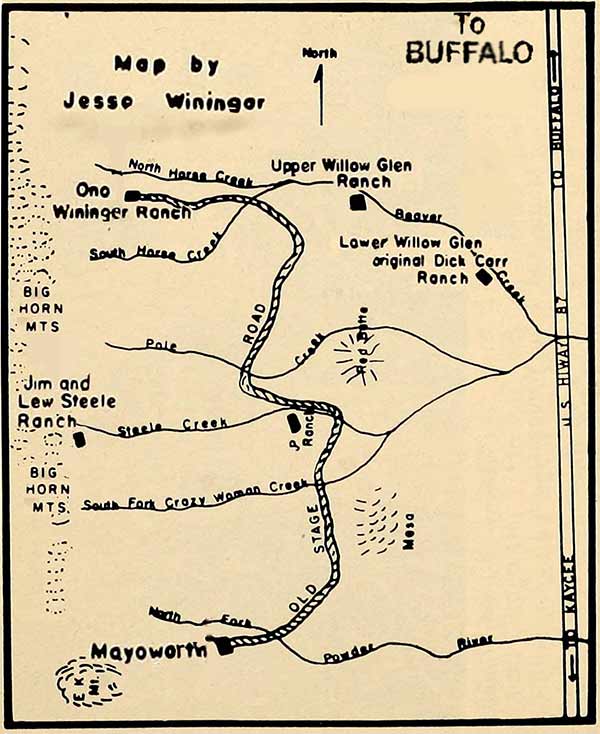
Map from
ANNALS OF WYOMING, THE HOLE IN THE WALL
by Thelma Gatchell Condit, April 1960, p.87-95.
Three P.M. found him on the western side at a spot
called the "Pole Patch." Here one of Wyoming's dreaded
three-day blizzards overtook Sam, the severity of
which was alarming. Losing his wav, Sam finally found
shelter in a small ravine. Having no bed, he kept a
small fire going all night, and, when he could, the
next day and the next day after that. On the third
day, the storm having slackened somewhat. he followed
the ravine down into Little Canyon Creek. Struggling
frozenly through the deep snow and brush: he
progressed very little distance that day, and night
overtook him while still in the canyon. Here he could
find no dry wood for a fire and spent a thoroughly
disagreeable night. burying himself in the snow to
keep from perishing.
Below,
the above Jesse Wininger map superimposed at
approximate position in current map.
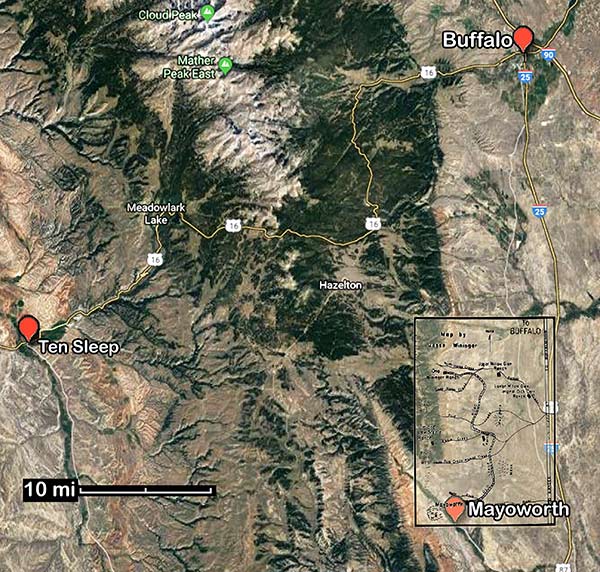
The next day he reached the Frank Simmons ranch on
Canyon Creek where he got a warm meal and a horse. Sam
arrived at the Ten Sleep post office April 3rd, five
days after leaving Ono. Most men deprived of sleep for
four nights and suffering from intense physical
exertion and exposure would have felt they had a rest
coming, anyway a chance to relate their recent
experience, but Old Sam was thinking of his hungry,
shivering, shelterless mules on top of the mountain.
who were needing attention as much as he was. They'd
been out in that blizzard too and he wanted to find
out, as soon as possible, how they'd made out. So he
stopped just long enough to exchange mail sacks and
rode the Simmons' horse as far back as he could in the
deep snow. When the horse could no longer make it, he
turned him loose, headed him homeward and buckling on
his snowshoes, proceeded slowly. wearily but steadily,
making the Pole Patch that same night.
The next morning he awoke stiff and sore in every
joint and muscle. It seemed physically impossible for
him to continue, which situation became doubly serious
when one snowshoe broke, becoming completely unusable
soon after he started out. No words can describe the
next five days' agony, the final pitiful crawling on
hands and knees, the tortured twelve miles to his
cabin, his own numb suffering, urgently needing to
reach his faithful old mules.
On the morning of April 7th, at 3 P.M. he stumbled
into his cabin. Even at first he knew someone had been
there, and, looking toward the wagon. he saw the mules
were not there. Someone must have untied them or
they'd broken loose. His hands, feet and legs were
badly frostbitten from crawling through the snow. so
he remained at the cabin for several days, resting and
nursing his aching. weary feet and hands. Then, after
rigging up another snowshoe, he again started out,
having provisions left for only one meal. When that
evening he paused to eat and rest, he looked up and
saw his mules approaching. He took off his snowshoes
and, making a halter out of the shoe straps, he caught
the most gentle mule and started out leading this mule
with the others following. Every time a bare spot of
ground appeared on a little knoll Sam stopped to rest
and let the poor critters crop the sparse grass.
At length, however, Sam became so weak he had to again
crawl on hands and knees and at last, finding himself
some slight shelter in some timber, was forced to stop
to rest again. He could no longer be responsible for
the mules. It was, indeed. fortunate that he was here
in the trees for that night another three-day blizzard
hit. How Sam ever survived, God only knows, huddled up
against a tree with no food and no extra protection.
When the storm had spent its fury he somehow went on
to Clarkson's Canyon ranch on Powder River, where he
was tenderly cared for and as soon as possible taken
to Buffalo to have his frosted parts properly attended
to by a doctor.
W. W. Morgareidge, A. L. Brock and a couple of other
men had gone to Sam's cabin in search of him when he
did not return with the mail. Finding the mules tied
to his wagon, they'd turned them loose, and seeing no
signs of Sam decided he'd perished in the storm.
They'd gone to Buffalo to report his probable death
and organize a search party to find the body., but an
hour after their arrival in town news came of the
Invasion into Johnson County of the armed cattlemen
and in the high excitement and confusion following
this announcement Sam Stringer and the storm on the
Big Horns was completely forgotten.
Sam's
harrowing experience in no way daunted his desire to
continue his mail carrying and as soon as his poor,
sore fee healed sufficiently he was back on the job as
faithful and dutiful as ever. He knew, and said
so many times, that his surviving was due entirely to
his grease-eating habit.
Later
this story is told about him when his stage was really
mired down in mud, the vehicle was just plain stuck
and the passengers and everybody had to remain out all
night. Luckily it wasn't unduly cold for the time of
year so no one actually suffered from exposure. hut
their dispositions weren't of the best. Among the lot
was a Jewish man who the story goes, had been
especially rude to Sam, expostulating hatefully bout
mail carriers who did not provide food for their
passengers upon such occasions. etc. etc.. for as
Uncle Sam had no more in the line of food than his can
of grease and a small skillet for the heating of it.
Soon after sunup Sam had managed to get together
enough dry wood for a small fire over which he was
preparing to warm up his grease when out of nowhere.
it seemed, appeared a long, lanky, bareheaded cowboy
all splattered and caked with mud. carrying his hat
full of eggs. Grinning at everybody and looking at the
pan of grease on the fire he said. "How about cookin'
some o' these here eggs for me. Sam?" "Sure." said
Sam, and so the cowboy squatted down on his heels and
held his hat close while Sam broke several eggs.
dropping them carefully in the hot grease. At the
sight of food the passengers. particularly the Jew,
crowded close hoping to get some of the food. too. Sam
went on frying the eggs. lifting the pan and expertly
tipping it this way and that to baste them on top. As
soon as they were cooked to his taste he laid them in
a row on a piece of old dirty canvas he had. When the
last egg was frying he looked up at the cowboy and
said. "lke. come to think of it. where'd you get these
eggs, anyway? What kind are they? They don't look
quite normal and don't smell quite normal to me." The
cowboy replied. "Hell, Sam. you're what's not normal,
them's rattlesnake eggs and ain't good as hen's egg.
but right now I'm so hungry I could eat my bridle
reins if they weren't so danged muddy." Needless to
say Sam and Ike ate the eggs, grease, dirt and all,
for the passengers had suddenly become very
fastidious and not as hungry as they thought they
were.
Speaking of finical passengers, another time Sam
unavoidably had to stop at a ranch along the road
instead of the usual stage stop. A Mexican was cooking
there and the table and food weren't of the cleanest
and the flies were so thick you could scarcely see
what was on the table. A very gentlemanly passenger
was very hungry and decided bread and syrup would
probably be safe and the least apt to be contaminated
or poison him. Very distastefully he began brushing
the flies off the syrup pitcher when a man remarked
good-naturedly, "Sir; don't worry none about them
flies. They're educated, they won't fall in."
In summing up the life of this remarkable old pioneer,
Mr. Gatchell writes: "Samuel Stringer saw a vast
empire wrested from savage domination and become the
home of a prosperous, contented people. He saw the Old
West pass out and adapted himself to the changed
conditions. He came back to the country where, years
before he had endured the hardships incident to life
in a frontier post and took his place in the new
regime as one of our most respected citizens."
These words written by H.P. Liddon come to mind:
NOBEL ACTION: The life of a man is made up of
action and endurance; and life is fruitful in ratio in
which it is laid out in noble action or in patient
perseverance. |
|
|
|
|
|
SEARCHING FOR
SAMUEL STRINGER "SR." BEFORE 1840
1820 Census,
Sampson Co., NC - Is this the same Stringer family
from the 1840 census in Florida?
There is a Samuel
Stringer in Sampson County, North Carolina on the 1820 NC census.
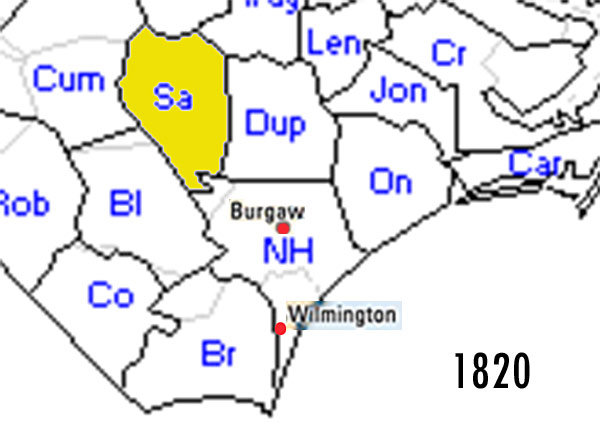
Sampson,
Duplin, and New Hanover counties as they appeared in
1820.
In 1875
Pender County was formed from New Hanover County to
include Burgaw (where Sheldon's brother Alexander was
born.)
Place
your cursor on the map to see the present layout.
1820
Census, Sampson County, NC comparison with the
Fla. census of Samuel Stringer in 1840

The Samuel Stringer head of house on the 1840
Florida census was age 40 to under 50, so in 1820 he
should be 20 to under 30. He would fit in
the 26 to under 45 group and thus the overlap would be 26 to under 30
if this is the same Samuel Stringer. His birth
year would be 1791 to 1794 so Samuel's data as the
head of house is consistent between the two
censuses.
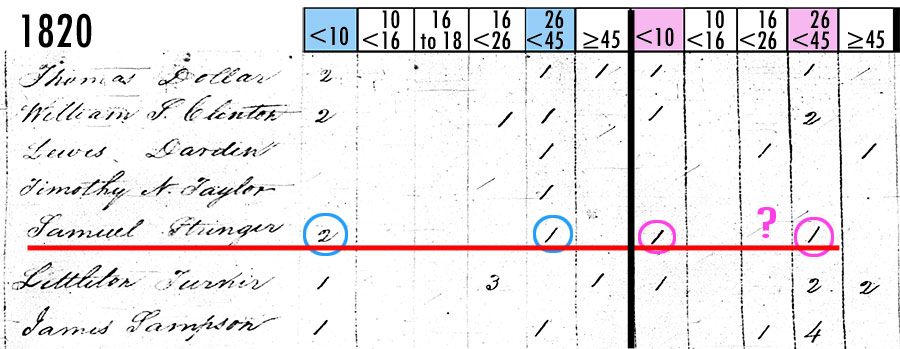
The two males in 1840 who were age 5
to under 10 would not yet have been born in 1820 and
are consistent with Sheldon b. 1834 and Samuel b.1831
of the Tampa 1850 census. The two males who
are under 10 in 1820 would have been born from 1811 to
1820 so in 1840 they would be from age 21 to 29, old
enough to be on their own. Alexander b. 1817 in
Burgaw, NC would be one of these two, leaving one
unknown male child. There are no males
in the 20 to under 30 group in 1840 so this is
consistent and thus, all the males are consistent and
Samuel could have had 4 sons, 3 of them being
Alexander b. 1817, Samuel b. 1831 and Sheldon b. 1834.
The fourth son could have been born before Alexander
or just after him.
The
female in 1840 who was under age 5 would not have been
born yet in 1820 and is consistent with Sheldon's
sister Laura, found on the Stringer 1850 census of
Tampa, b. 1836-37 in Georgia. The female in 1820
who is under 10 would be age 20 to under 30 in 1840
and although there is no female in the Stringer home
in that age group in 1840, she would be old enough to
be married and thus would qualify as Mary Ann Stringer
Drew who is listed in that group in the neighboring Benjamin Drew
household. So the female under 10 in 1820
can be Mary Ann Stringer Drew. The female
on the 1840 census who was 15 to under 20 (b. 1821-1822) would
not yet have been born in 1820 and would be Jane
Stringer who married William Hammley in 1841.
Finally, the female age 10 to under 15 (b.1826-1830)
in 1840
would also not have been born yet in 1820 and would be
Martha b 1827 to 1830 in NC.. So thus far the
females are consistent and Samuel could have had 4
daughters who can be:
Mary Ann Stringer Drew b. Jan. 20, 1820 Wilmington, NC,
Jane
Stringer Hamley b. 1819-1822
NC or GA,
Martha Stringer Cook b. 1827-1830 b.
NC,
and
Laura b. 1836-37 GA.
MARY
(maiden name unknown) STRINGER, Sheldon's mother
Finally, the female in 1840 who is assumed to be
Sheldon's mother, Mary Stringer, in 1840 is age 40
to under 50, so in 1820 she would be age 20 to under
30. She would be in the 26 to under 45
group in 1820. The overlap would be 26 to under 30 in 1820 and she fits in with both censuses. So the oldest
females of both censuses are consistent.
However, Sheldon's mother, Mary Stringer, who has a birth
year of 1796 on her tombstone and at age 51 on her
1850 census, would have a birth year of 1799, thus
making her age 21 to 24 in 1820. There should have
been a female in 1820 in the 16 to under 26 group. Instead, there is
a female listed in the 26 to under 45 group.
In 1820, she already
had 3 children all under the age of 10. If Sheldon's mother was 2
years older (b. 1794-95) she would be consistent with 1820
and 1840. (Her tombstone and 1850 census have a 3-year
discrepancy.) Could she have
tried to appear a couple of years older in 1820 and
say she was 26? Could Samuel have thought she
was 26? Mary Stringer's age is rather
consistent with her tombstone birth date for her remaining censuses: 63 in
1860, 73 in 1870, all calculating to a 1796-97 birth
year.
In a nutshell,
the 1820 and the 1840 censuses for the female who would be
Mary, Sheldon's mother, are consistent with each other.
But Mary's tombstone birth date is 2 years off to fit in the
1820 census.
These Stringers should also be
on the 1830 census with a female under
5 (Martha), a female 5 to under 10 (Jane), a female 10 to under 15 (Mary
Ann), a female 30 to 40 (Mary Stringer), a male 10 to under
15 (Alexander), and a male 30 to under 40 (Samuel Stringer,
Sr.) Their 1830 census should be in North Carolina, as
Samuel (Jr.) and Sheldon were both born there 1831 and 1834.
So far, this census has not been located.
All the above circumstances
strongly point to Samuel Stringer as Dr. Sheldon Stringer
Sr.'s father, and that the Stringers probably came to Tampa
with the Moores, the Drews, or the Givenses, sometime around 1842 to 1849.
But did Samuel Stringer make it to Tampa? The 1948
Tampa Tribune article has Sheldon Stringer, Jr. saying their
house was built in 1842 by his grandfather.
Putting all the Stringer children together:
|
1. Alexander |
b. 1817 |
b. Burgaw, NC |
In the 1820 home |
Moved out by 1840 |
|
2 son |
b. 1817** to 1820 |
? |
In the 1820 home |
Moved out or dec'd
by 1840 |
|
3. Mary Ann |
b. 1820 |
b. Wilmington, NC |
In the 1820 home |
Married out in
1839 to B.Drew |
|
4.
Jane |
b. 1821 to 1822 |
b. NC
or GA |
Not
yet born in 1820 |
In the 1840 home,
married out 1841 |
|
5.
Martha |
b. 1827 to 1830 |
b. NC |
Not
yet born in 1820 |
In the 1840 home,
married out 1849 to J. Cook |
|
6. Samuel |
b.
Sep. 30, 1830 |
b. near Washington, NC |
Not
yet born in 1820 |
In the 1840 & 1850 home |
|
7. Sheldon |
b.
Nov. 13, 1834 |
b. NC |
Not
yet born in 1820 |
in the 1840 & 1850 home |
|
8. Laura |
b. 1837 |
b. GA |
Not
yet born in 1820 |
In the 1840 & 1850 home |
| |
|
|
|
|
|
**#2 son
statistically could have been born from
1811-1820 but his mother's age and her probable
marriage year at age 21 restricts him to 1817 at
the soonest. |
So far,
Samuel "Sr." hasn't been found on the 1830 census.
Assuming he is Sheldon's father, he would likely be in
NC because Sheldon and Samuel were both born there.
SO WHAT
COULD HAVE HAPPENED TO THE SENIOR SAMUEL STRINGER
BETWEEN 1840 AND 1850?
|
Newspapers of this
period would publish the names of persons who
had unclaimed U.S. Mail at the local post
office. On January 4 and 25, April 4 and
11, and May 2, 1832, the Wilmington NC newspaper
"Cape Fear Recorder" named Sam or Samuel
Stringer among others having mail.
The 1881 Sunland Tribune article states that Dr. Sheldon Stringer "was left
fatherless when he was only eleven." Using
his 1834 birth year which is consistent with his
tombstone and 1850 census, his father would have
died in 1845. |
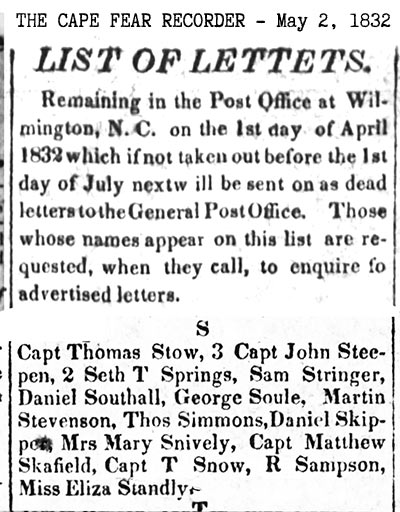 |
|
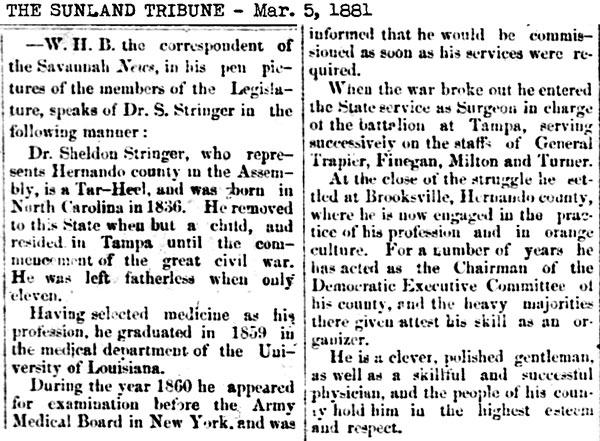
If Sheldon's
father was the Samuel Stringer in the article at
right, he returned to Wilmington for some reason and met with a
most tragic end. There are no other
records found so far for any Samuel Stringer in this area of NC in this
time period. Samuel wasn't a common name among Stringers. |
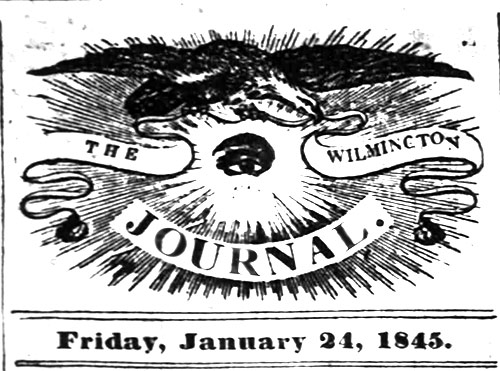 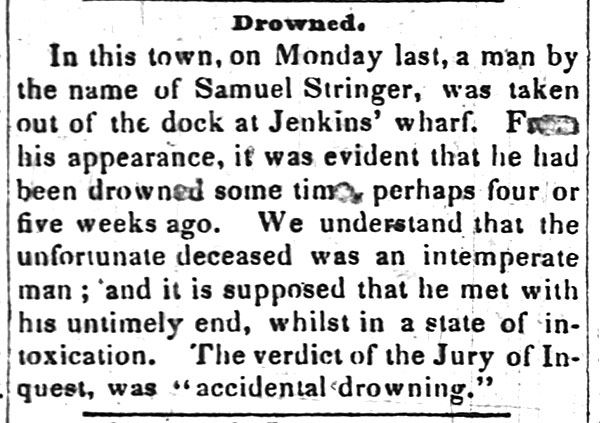 |
|
|
|
|
STRINGER LAND
PATENTS IN FLORIDA
Sheldon
Stringer had several land patents in Florida--Pasco and
Hernando Counties. Assuming Alexander was his oldest
brother, it would make sense that he had the earliest one.
He may have intended to move to Florida while he was
in Texas serving in the Army. His was the largest
single purchase at 160 acres (one-quarter of a section.)
A half of a quarter was 80 acres, and a quarter of a quarter
was 40 acres. So Sheldon had three purchases for 40,
80 and 40 also totaling 160 acres (in two counties.)
Could other Pasco and Hernando patents be relatives?
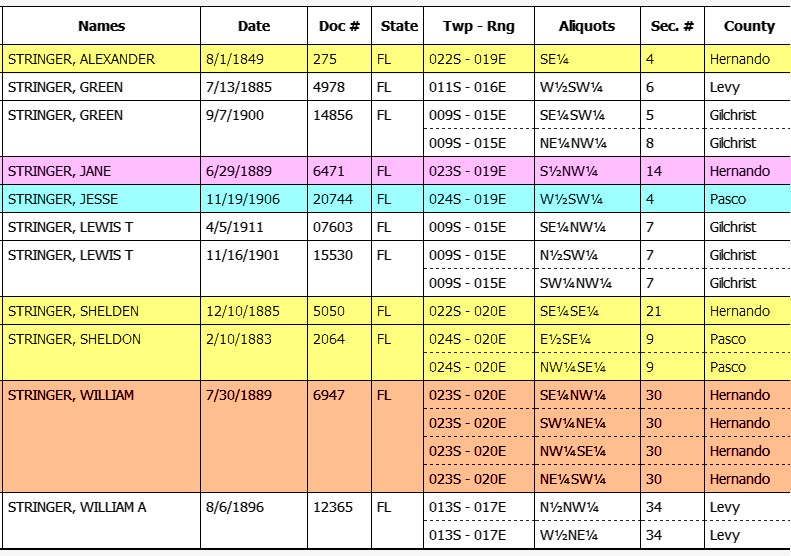 |
|
THE
EDGECOMBE COUNTY, NORTH CAROLINA STRINGERS
A great many
Stringer families were present in the early 1800s in the
area of Edgecombe County, NC. These two newspaper
articles from the Rocky Mount Telegram newspaper in 1955 and
1957 provide valuable information about the Stringers in the
early 1800s.
|
|
GUILFORD
STRINGER AND MARY PITT
Guilford Stringer and his family "sold out and moved
south before 1840 and lost all connection with their
relations back in Edgecombe County."
The articles
from the 1950s are only portions of the larger articles
which discuss other Stringers and other families.
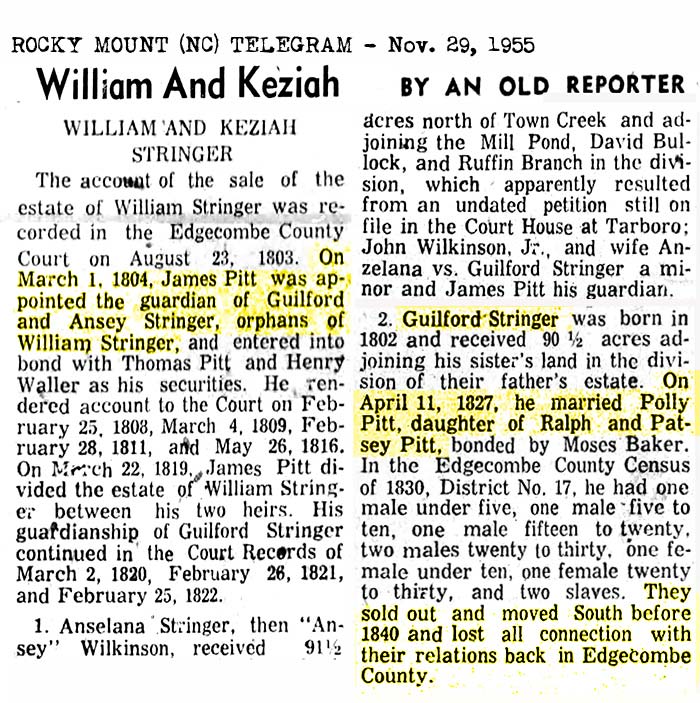 |
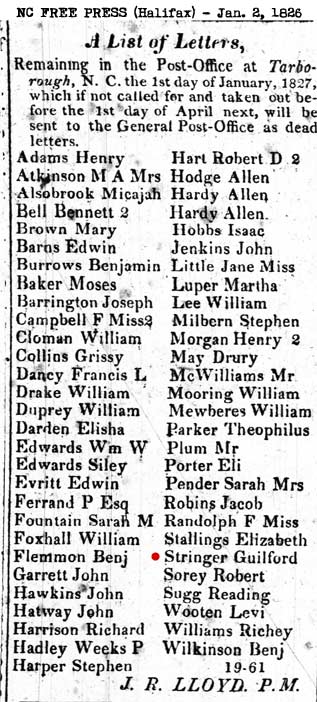 |
|
In the article
below, after Guilford Stringer closed the Mobley
mortgage and sold his land to Joab Pitt on Feb. 25, 1833,
they "moved south in the great migration of 1833 and lost
all contact with their kinsmen in Edgecombe County."
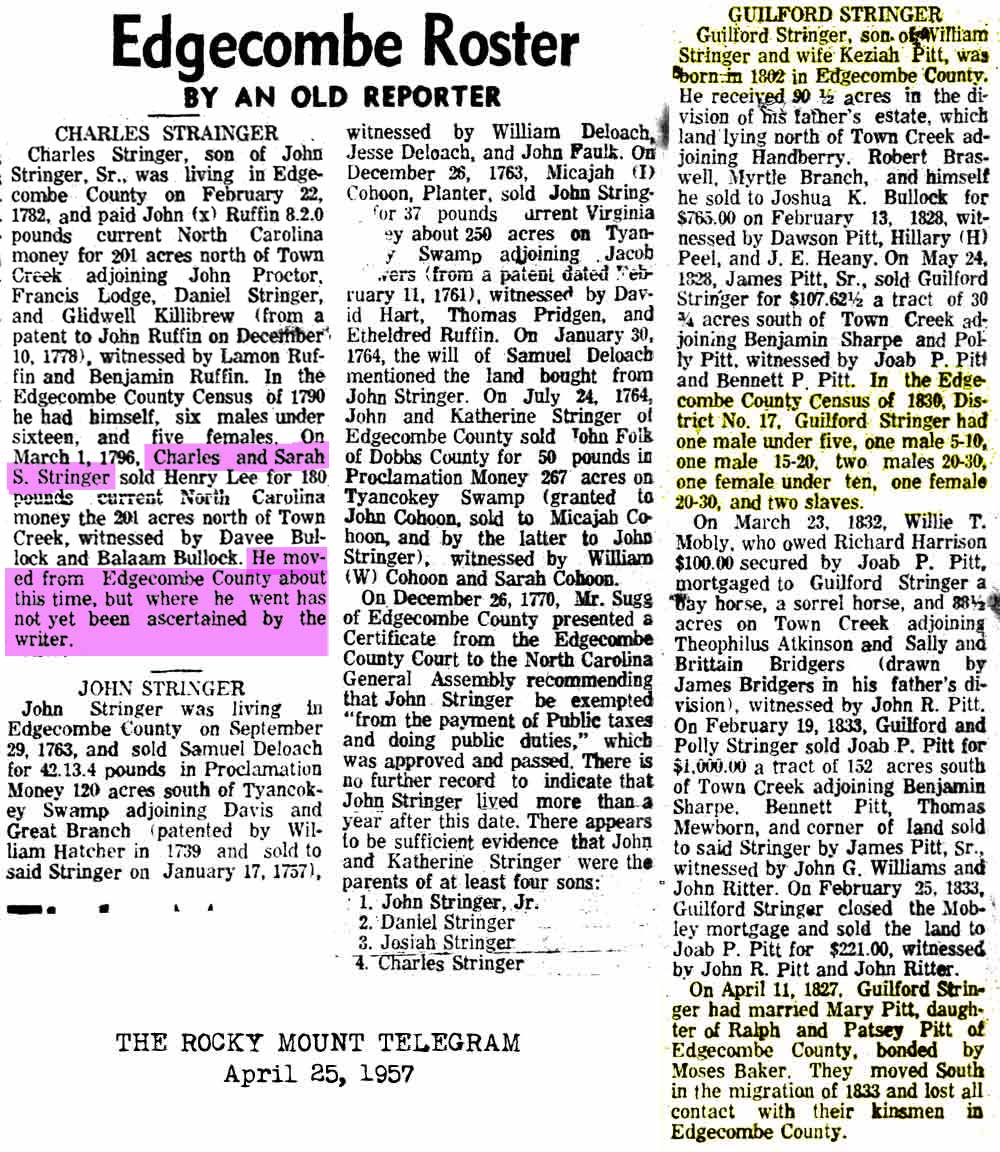
|
Marriage of
Guilford Stringer and Mary Pitt, April 11, 1827
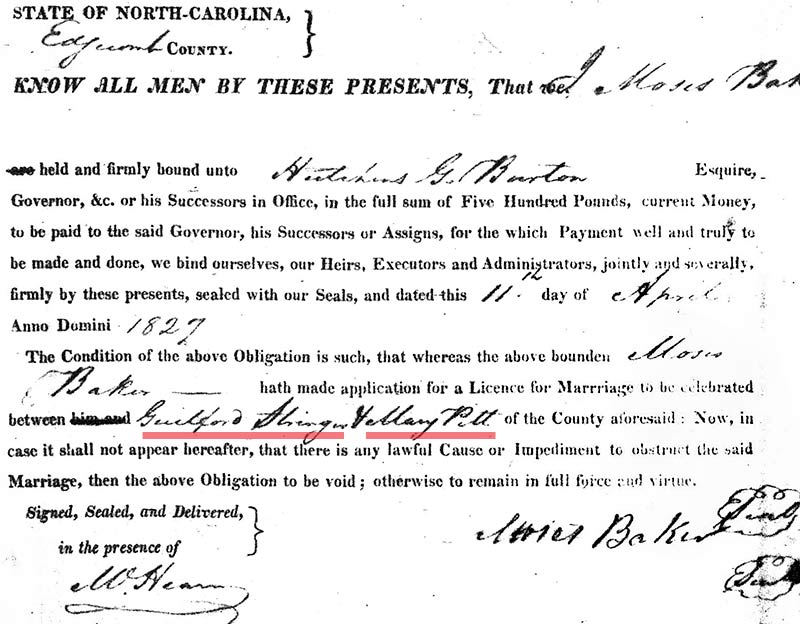
Although they could still be Sheldon
and Laura's parents, they wouldn't be Alexander's, Mary Ann's or
Jane's parents having
married so late.
Perhaps Charles Stringer or Josiah Stringer, sons of John Stringer Sr,
could be Sheldon Stringer Sr.'s grandfather.
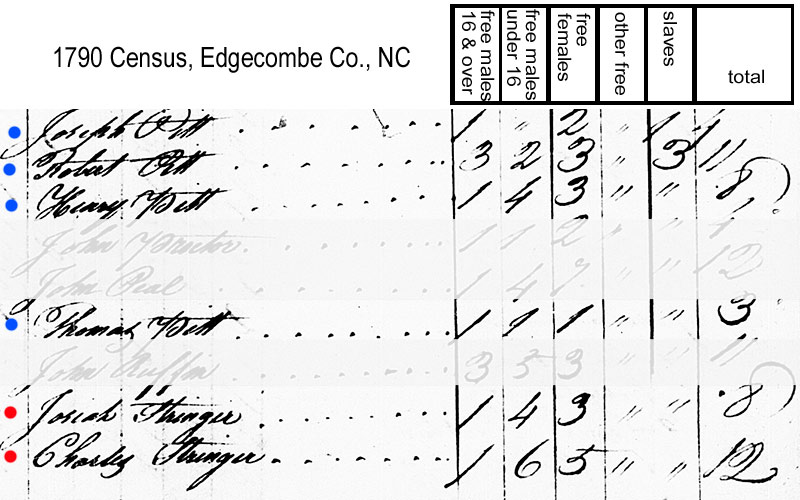
Four Pitt families living in close
proximity to brothers Josiah & Charles Stringer.
Charles with 6 males under age 16 = born circa 1774 to 1790.
Josiah with 4 males under 16. One could be Samuel Stringer.
https://www.familysearch.org/ark:/61903/2:2:3DHD-S77
Charles Stringer listed on the 1790 census, p.
56, had one white male over 16 (self), 6 w/m under 16, and 5 free
white females.... Charles was awarded land in the 1805 Georgia
land lottery in what became Laurens County, and was on the the
first grand jury of the first court in that County. By 1818, he
had sold all his land in Laurens County in preparation of his
families move to Lawrence County, Mississippi. while other
researchers believe that Charles died in Georgia before he could
make the move to Mississippi, there is the Charles Stringer listed
in Lawrence County, Mississippi in the 1818 tax rolls, (while he
paid a tax of .67 he is not shown to own any land, but one slave)
and again in 1823 Charles is mentioned. My source for much of the
information on his family, Dorothy Stringer Roberts, believes that
Charles made the move and died in Mississippi in his 70s; I agree
with her conclusion.(taken from the Internet. I don't know who
wrote it) Quoted text:
http://trees.ancestry.com/pt/AMTCitationRedir.aspx?tid=9464606&pid=5686
Submitted 3/11/2017 by ANDRIA VINCENT |
Consider the four sons of John Stringer Sr.,
with 13 male children combined on their 1790 census, any of whom could be
Samuel Stringer's father.
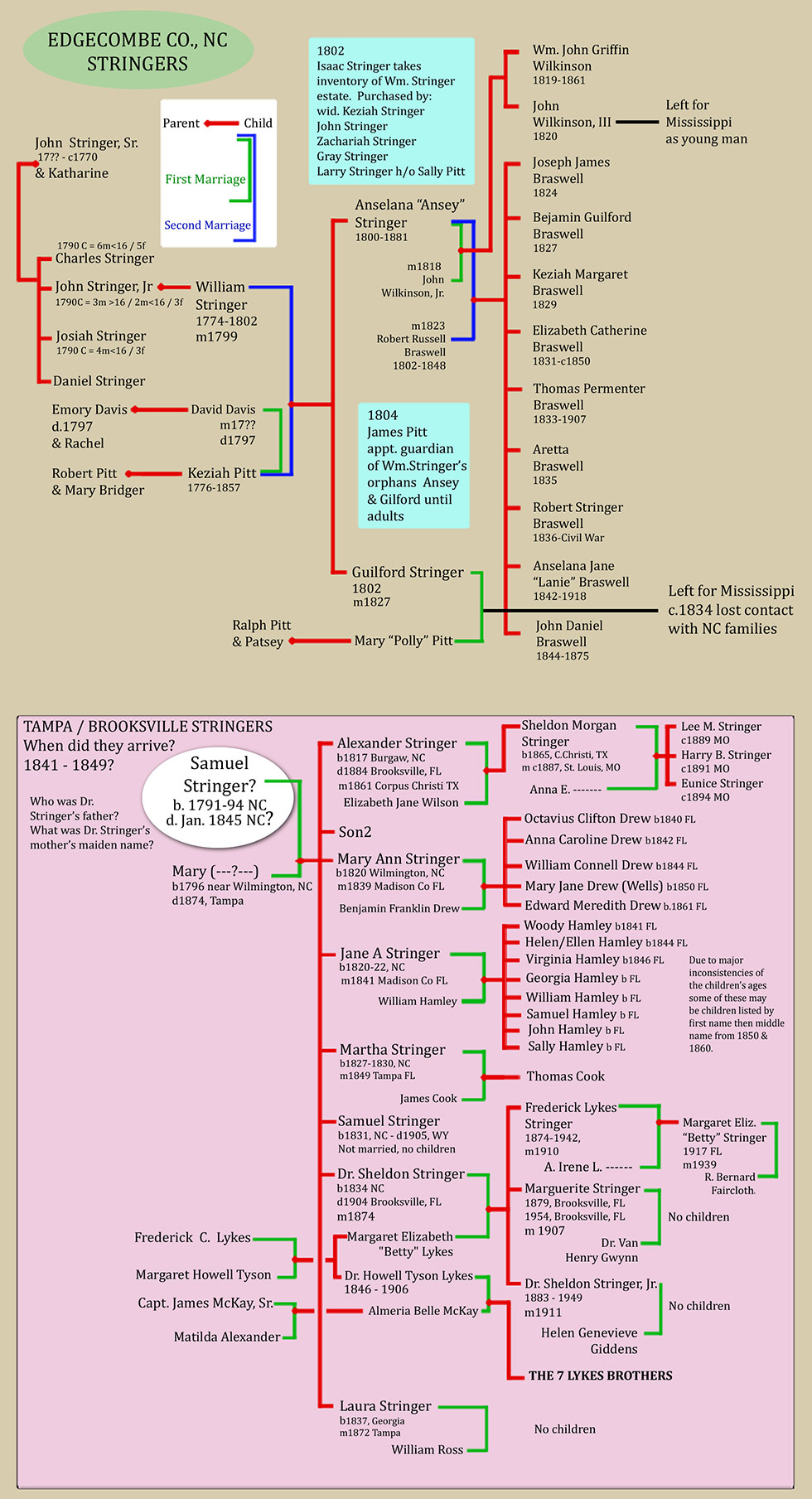
Dr. Howell T. Lykes (brother-in-law of Dr.
Sheldon Stringer, Sr.) is included in this tree so that the relationship
between the Stringers and the seven "Lykes Brothers" can be seen.
History of Edgecombe Co., NC
By Joseph Kelly Turner, John Luther Bridger
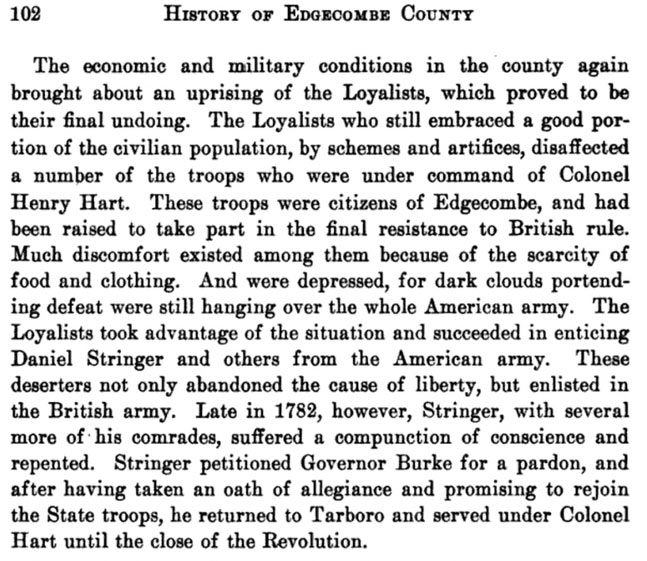
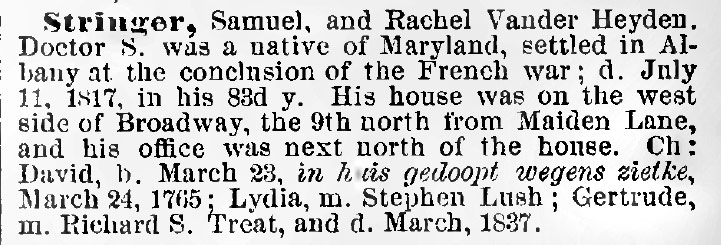 Doctor Samuel Stringer of the American Revolution: Doctor Samuel Stringer of the American Revolution:
Samuel Stringer
(1734–1817), an Albany physician whose clientele included the Schuyler
family, was an active member and sometimes chairman of the town’s
committee of correspondence before August 1775 when Philip Schuyler
asked him to undertake the task of establishing a hospital for the
northern department (Schuyler to Stringer, 27 Aug. 1775, DNA:PCC,
item 153). The Continental Congress confirmed Schuyler’s action on 17
Sept. by naming Stringer director of the hospital and chief physician
and surgeon for the army in the northern department. Stringer was
authorized to appoint up to four surgeon’s mates to assist him, but they
were to be employed only when the sick and wounded were “so numerous as
to require the constant attendance of four [mates]” and were to be
reduced in number as circumstances allowed (JCC,
2:249–50).Three
children: 1) David b. 1765, 2) Lydia m. Stephen Lush, 3) Gertrude m.
Richard Treat.
|
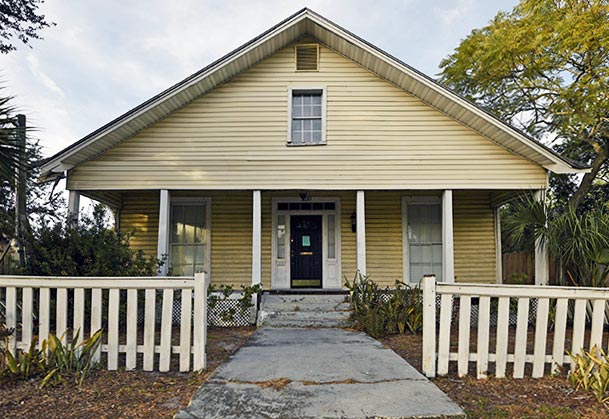



 The
1842 map at left from the University of Florida digital map
collection shows Madison county's eastern boundary was the
Suwannee and Withlacoochee Rivers, it's western boundary the
Ocilla River, northern boundary the Georgia state line, and
southern boundary its coast along the Gulf of Mexico.
The
1842 map at left from the University of Florida digital map
collection shows Madison county's eastern boundary was the
Suwannee and Withlacoochee Rivers, it's western boundary the
Ocilla River, northern boundary the Georgia state line, and
southern boundary its coast along the Gulf of Mexico.












































